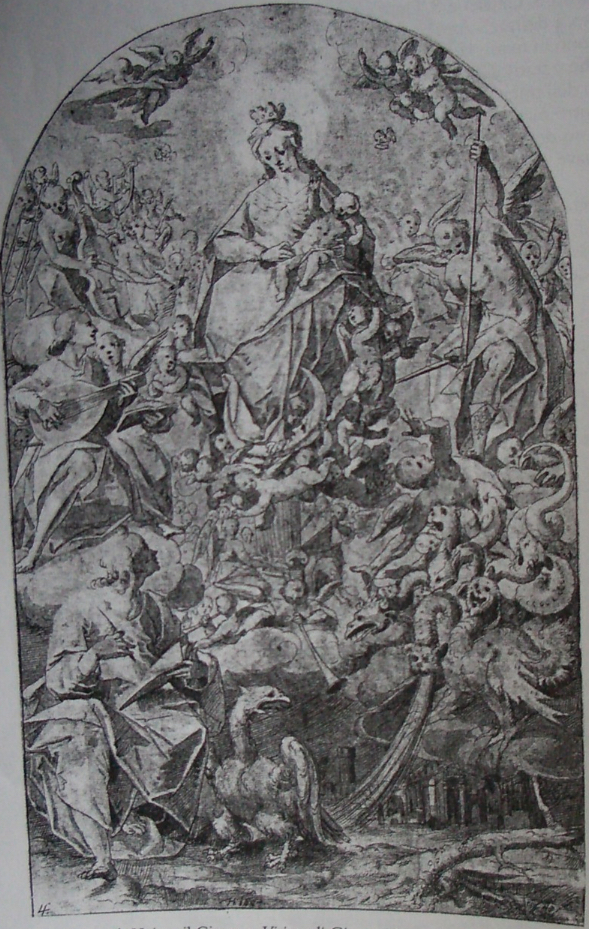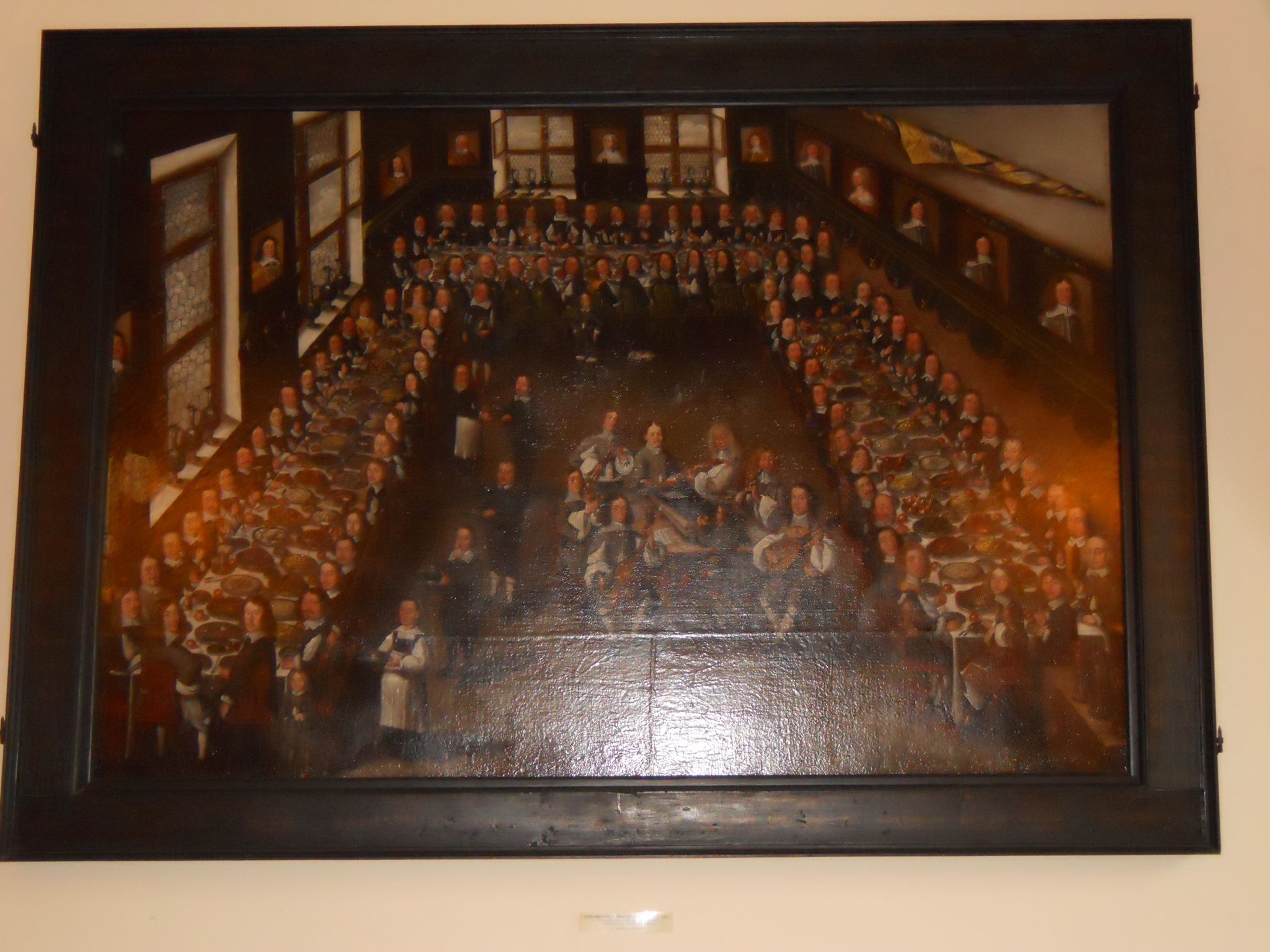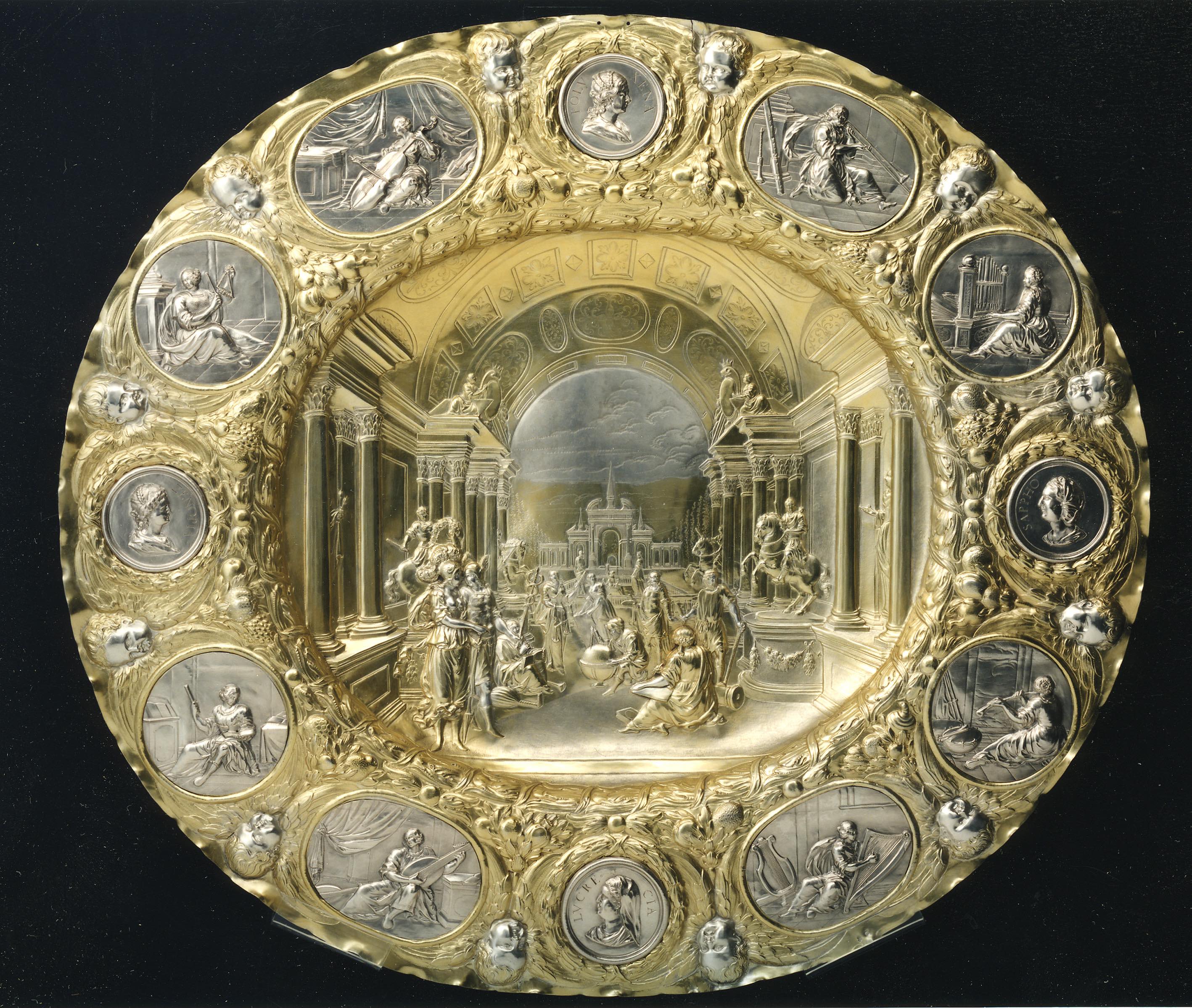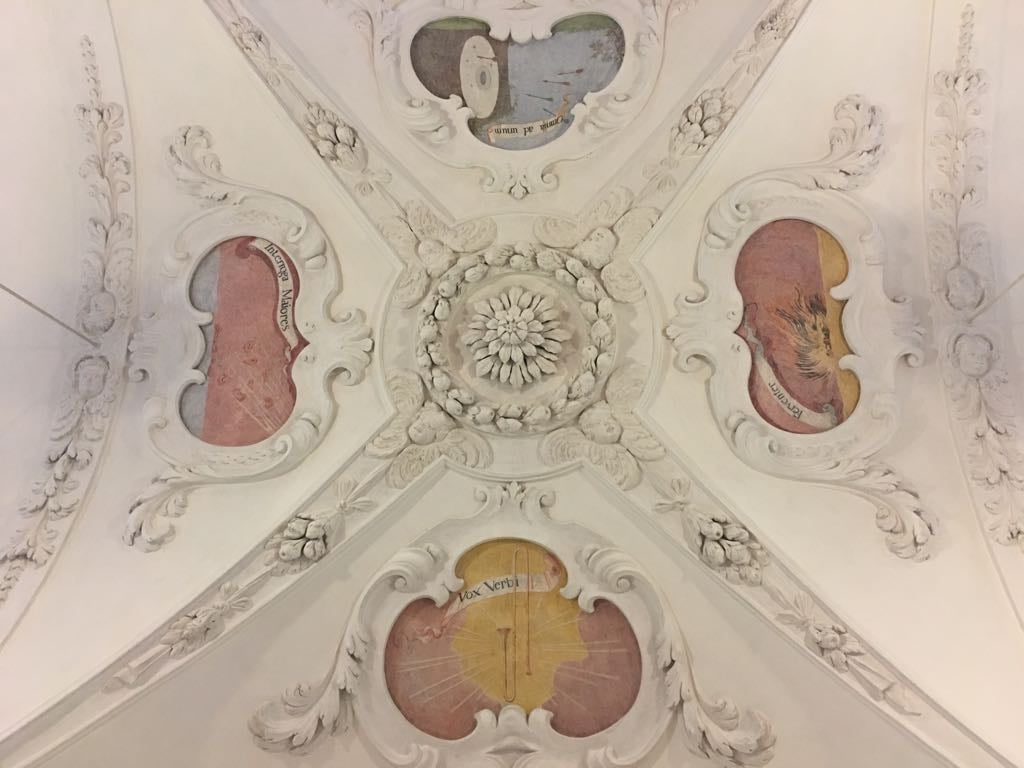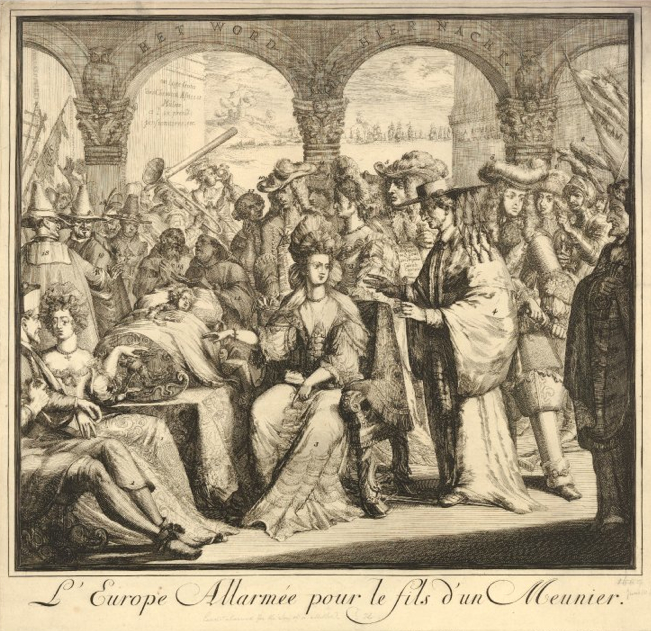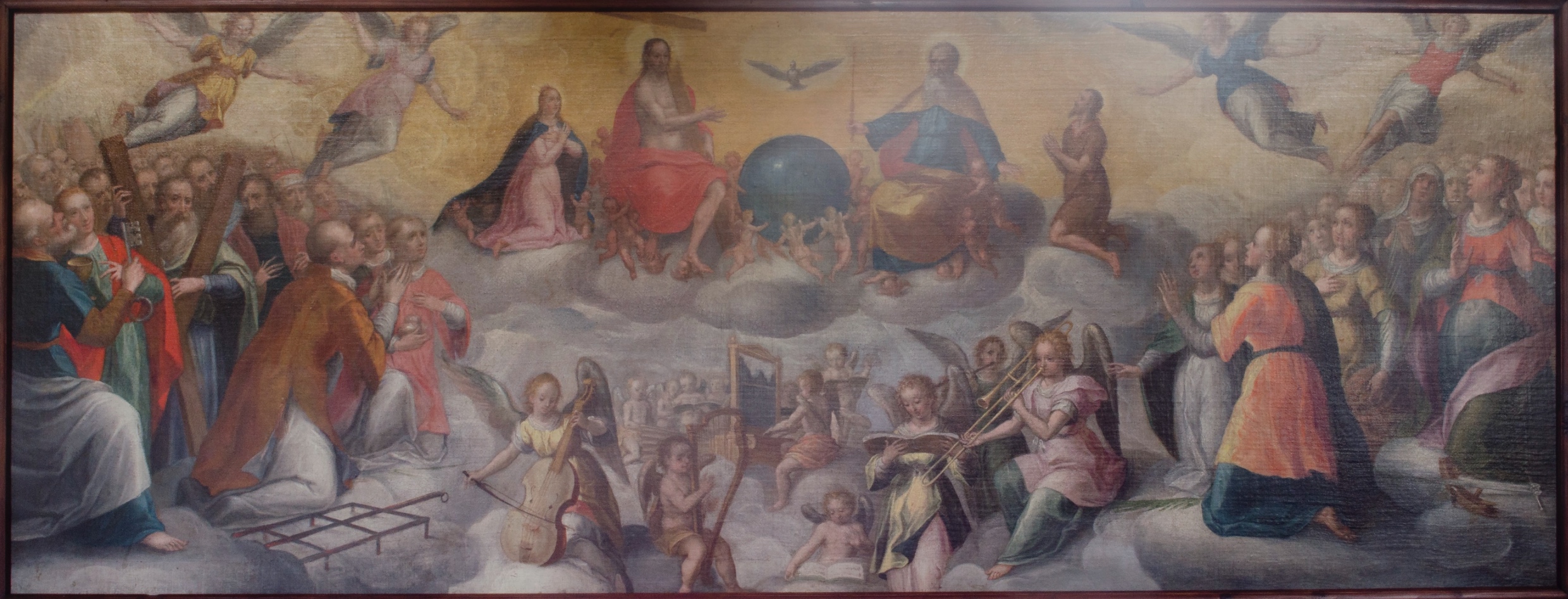A history of the trombone in timeline form. For sources see Trombone History Bibliography.
_______________
1651—Dresden, Germany: Musicians for Johann Georg I (ruler of the electorate of Saxony), where Heinrich Schütz is Kapellmeister, include a trombone player named Daniel Philomethes (Spagnoli 3-4).
1651—Frankfurt, Germany: Johann Andreas Herbst writes Domine Dominus noster, which calls for 3 trombones (Collver 123).
1651—Venice, Italy: Italian composer and organist Massimiliano Neri issues a collection of sonatas, Sonate da sonarsi con varii stromenti, scored for diverse combinations of instruments, including trombones. Regarding instrumentation, the collection’s preface mentions that performers may adapt instrumentation “to their taste.” Many of the sonatas may have been intended for the wedding of the Habsburg emperor Ferdinand III (Selfridge-Field, Instrumentation). Sonata 8 is scored for 2 cornetts, bassoon, and 3 trombones; Sonata 11 is scored for 2 violins, viola, 2 cornetts, bassoon, and 3 trombones; Sonata 12 is scored for 5 violins and 5 trombones; and Sonata 14 is scored for 2 cornetts, bassoon, 3 trombones, 2 violins, viola, and tiorba or viola (Collver 63; Winkler 304).
1651—Modena, Italy: Mattia Preti’s fresco, Gloria di Angeli Musicanti, located in the apse of San Biagio, includes a depiction of an angel playing trombone among many other angel musicians (see detail and full image below; public domain) (Adani; Quintavalle plate 95).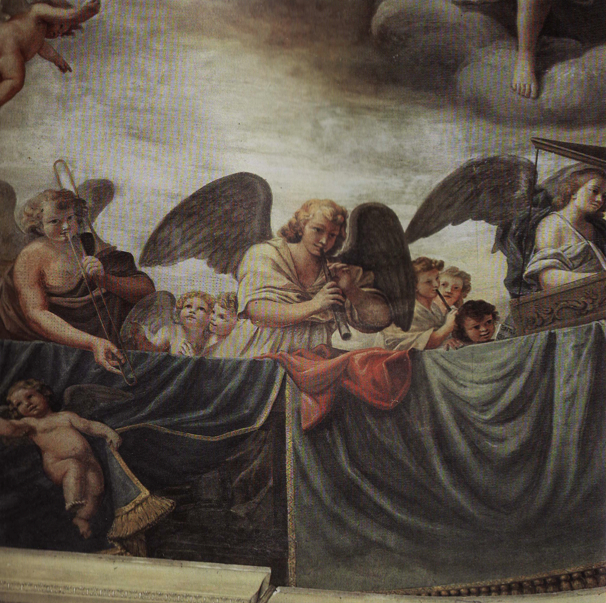
1651—Tópaga, Colombia: An inventory at a Tópaga church lists 4 trumpets, one of which is used to make a trombone (Bermúdez).
1652—Nuremberg, Germany: Sebastian Hainlein II manufactures one of the earliest extant alto trombones. The instrument is held in Marienkirche, Gdansk (Herbert, Trombone 313).
1652—Zittau, Germany: Andreas Hammerschmidt calls for 3 trombones in Lob- und Danck Lied aus dem 84 Psalm (Leonard, The Role of the Trombone…Mid- and Late Seventeenth Century).
1652/53—Johann Rosenmüller scores for alto voice, 2 violas or trombones, violone or trombone, and basso continuo in O dives omnium bonarum dapum (Leonard, The Role of the Trombone…Mid- and Late Seventeenth Century).
1652/53—Johann Rosenmüller scores for soprano and alto voices, 2 violas or trombones, violone or trombone, and basso continuo in O dulcis Christe, bone Jesu Charitas (Leonard, The Role of the Trombone…Mid- and Late Seventeenth Century).
1652/53—Johann Rosenmüller scores for alto voices, 3 violas or trombone, violone or trombone, and basso continuo in Amo te Deus meus amore magno (Leonard, The Role of the Trombone…Mid- and Late Seventeenth Century).
1652-55—Spain: The head of court minstrels, Francesco de Baldes, is ordered to begin a music school for minstrels. He is directed to form a wind band with the following instrumentation: 4 soprano shawms, 2 tenor shawms, 2 “contra altos de shawm,” and 4 trombones” (Whitwell, Baroque 69).
1652-55—Preonzo, Switzerland: A fresco in the ceiling of Chiesa Santi Simone e Giuda features a number of angel-musicians, including a trombonist (see below detail; public domain image; click on image to expand).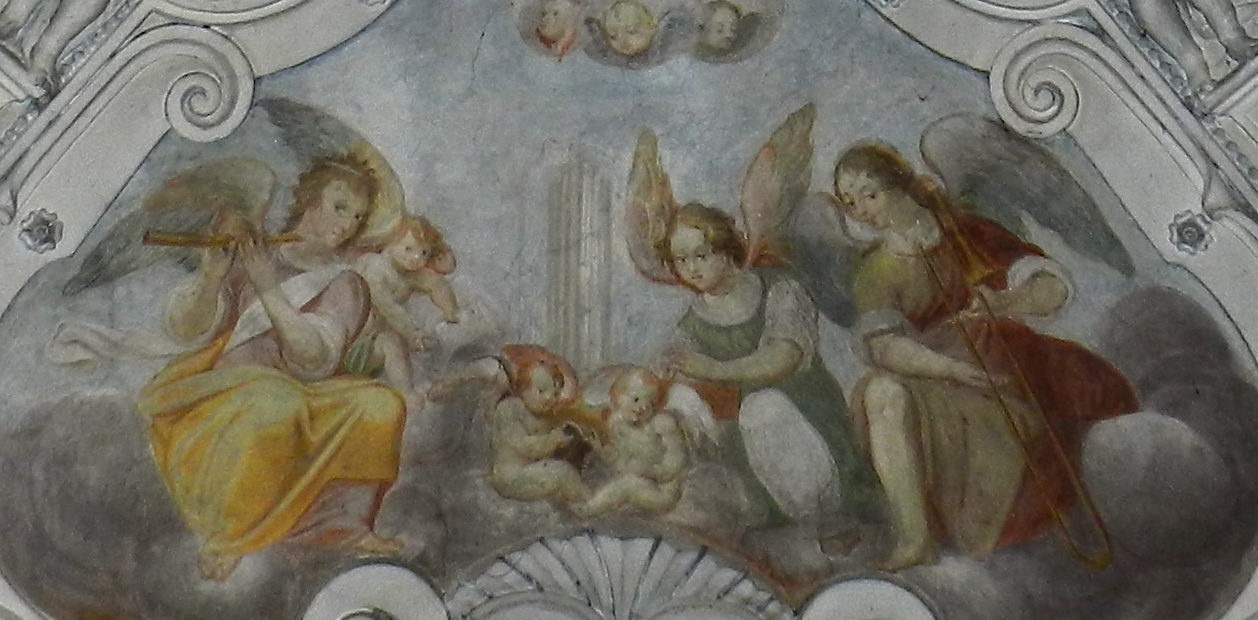
1653—Dresden, Germany: In a letter to his father, Johann George II proposes a court ensemble at Dresden (Germany) of 20 instrumentalists, including 6 trombone players (Spagnoli 146).
1653—Cambridge, England: Musicians at University of Cambridge inspire a poem by Nicholas Hookes: “We have good Musick and Musicians here, If not the best, as good as anywhere; A brave old Irish Harper; and you know English or French way few or none outgo Our Lutenists; the Lusemores too, I think For Organists; the Sackbuts breath may stink…” (Knight Cambridge 32; Payne 150).
1653—Sweden: Records of the activities of British Ambassador Bulstrode Whitelocke state, “In the evening, Whitelocke being reasonably well recovered, the music of the church here, about twenty persons, came to Whitelocke’s house, and brought with them their instruments of music, sackbuts, cornets, and violins, and did sing and play in his presence reasonably well, although not exactly; and for their pains Whitelocke bestowed on them forty six-dollars, whereof they were nothing shy in the acceptance. Whitelock was informed that these musicians were sent to him from the Archbishop of Upsal, who was newly come to town…” (Whitelocke 363).
1654—Plock, Poland: A trombone is added to the music ensemble at Plock Cathedral (Przybyszewska-Jarminska, The History of Music in Poland: The Baroque, Part 1, p. 98).
1654—Reims, France: Records of the coronation of Louis XIV at the cathedral of Reims describe a procession that includes wind and percussion instruments: “The king was escorted to the cathedral…preceded by a dozen trumpeters, drummers, fife-players, oboists, flutists, bagpipers and trombonists, all dressed in white taffeta” (Bowles, Musical Ensembles 281). Jean Le Pautre’s engraving depicting the coronation, titled La Pompeuse et Magnifique Cérémonie du sacre de Louis XIV, shows a wind band of 12 players, at least one of whom is playing trombone (see below detail; public domain image) (Hindley 221).
1654—Jindrichuv Hradec, Moravia (modern Czech Republic): Organist and composer Adam Václav Michna writes Missa pro defunctis, a Requiem Mass in which 3 trombones double vocal lines (Chase 127).
1654—Wolfenbüttel, Germany: A masque called Der Natur Ballet, by Sophie Elisabeth, is performed. It portrays the character of each of the 7 planets, using trombones and cornetts on the Jupiter portion (Spagnoli 46).
1654—Hans Hake writes for 3 trombones, 2 cornetts, and continuo, in Arias 37, 38, 39, and 40 of his Ander theil neuer Pavanen, Sonaten, Arien, Balletten, Brandlen, Couranten, und Sarabanden (Collver 52).
c. 1655—Weiden, Germany: Author and composer Wolfgang Caspar Printz learns how to play trombone and cornetto as a youth from a town musician and “assist[s] him by playing hundreds of times from the tower” (Rose, Musician-Novels).
1655—Venice, Italy: Biagio Marini’s Sonata Quarta a 4 from the collection Per ogni sorte di strumento musicale calls for 2 violins, viola or trombone, and basso (Winkler 304).
1656—Venice, Italy: Francesco Cavalli Musiche Sacre, a collection of 28 pieces, includes three optional trombone parts printed into the alto, tenor, and bass parts of the second choir (Glover 125).
1656—Venice, Italy: Francesco Cavalli scores for trombone and strings in 2 sonatas and 2 canzonas (Winkler 304).
1657—Visione di Giovanni Evangelista, an image by Joseph Heintz il Giovanni, includes an angel playing trombone among other angel musicians (see detail and full image below; public domain) (Stoccarda, Staatsgalerie, Graphische Sammlung).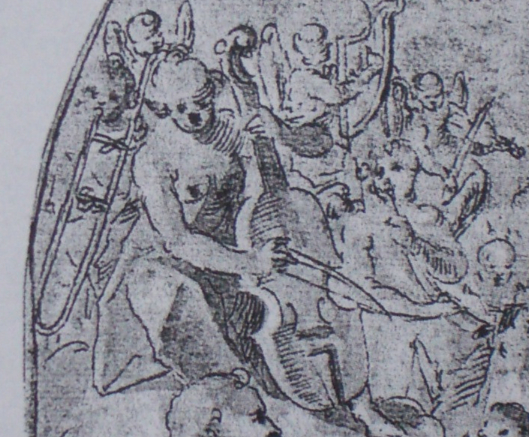
1657—Johann Rudolph Ahle scores for alto voice, 2 violas or trombones, violone or trombone, and basso continuo in Gehe aus auf die Landstrassen (Leonard, The Role of the Trombone…Mid- and Late Seventeenth Century).
1657—Johann Rudolph Ahle scores for alto voice, 3 violas or trombones, a violone or trombone, and basso continuo in Jesu dulcis memoria (Leonard, The Role of the Trombone…Mid- and Late Seventeenth Century).
1657—Johann Rudolph Ahle scores for SATB, cornetto or violin, 2 violas or trombones, a violone or trombone, and basso continuo in his Magnificat (Leonard, The Role of the Trombone…Mid- and Late Seventeenth Century).
1657—Johann Rudolph Ahle scores for SATB, 2 violins, 3 trombones or violas, trombone or violone, and basso continuo in his Missa a 10 (Leonard, The Role of the Trombone…Mid- and Late Seventeenth Century).
1657—Leipzig, Germany: A triumphal arch with concert of the muses, designed on occasion of the visit of Johann Georg II to Leipzig, includes a muse playing trombone (see below image; public domain) (special thanks to Bruce Dickey).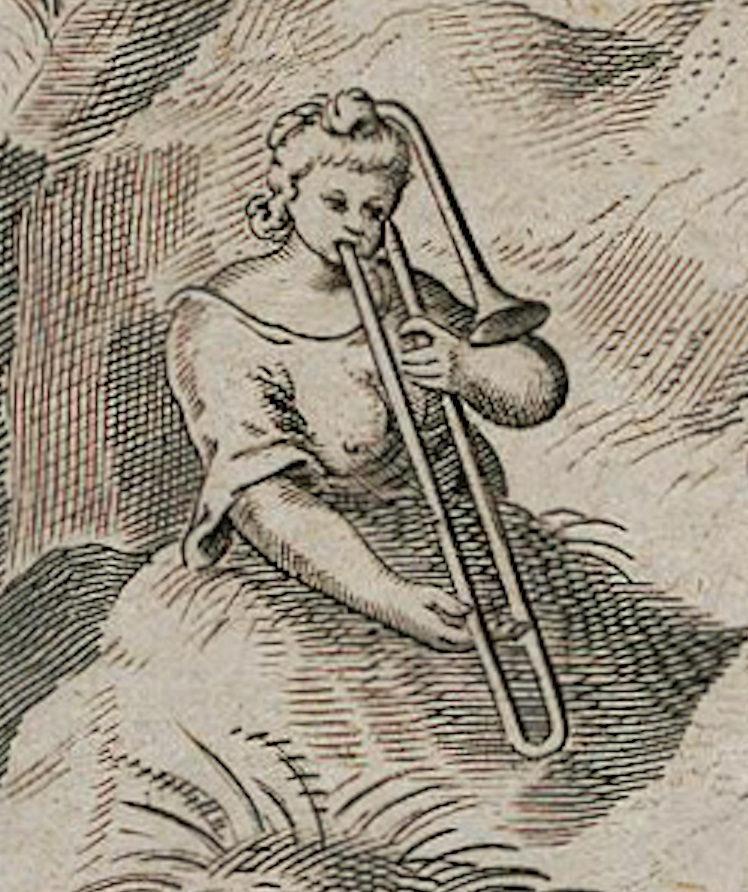

1657-1671—Bologna, Italy: During the period that Don Maurizio Cazzati is maestro di cappella at San Petronio, the number of trombones employed in the regular chapel is always 1-2 (Schnoebelen, Performance Practices at San Petronio 42; Enrico, The Orchestra 31).
1658—Bologna, Italy: The vestry board decrees that “a fixed number of musicians” should be established at San Petronio, including an instrumental body of 2 violins, 2 alto and 2 tenor violas, 2 trombones, 1 violone, 1 contrabasso violone grosso, 1 theorbo, and 2 organs. The decree stipulates that “the number shall never be increased, but should there be even one part lacking, his place should be filled with a similar one” (Allsop, Secular Influences; Schnoebelin, Cazzati vs. Bologna).
1658—Bologna, Italy: On the occasion of the patronal feast, 2 “outside” trombonists are brought in to supplement San Petronio’s 2 regular trombonists (Schnoebelin, Cazzati vs. Bologna).
1658—Venice, Italy: Johann Rosenmüller, an unfrocked priest and predecessor of J.S. Bach’s at the St. Thomas School in Leipzig, becomes a trombonist in the cappela musicale of St. Mark’s cathedral. Rosenmüller had fled from Leipzig a few years earlier (1655) after escaping imprisonment for offenses of pederasty. Later, also in 1658, he becomes the first foreigner to be hired as a teacher (maestro) at Venice’s Ospedale della Pieta, where he eventually assumes the role of music director. Near the end of his life, he returns to Germany to work as Kapellmeister at the Wolfenbüttel court (Baldauf-Berdes 188; Rose, The Musician in Literature 54).
1658—Christian Sartorius calls for 2 trombones the “Alleluja” of his Unterschiedlicher Teutscher (Collver 162).
1658—Görlitz, Germany: Georg Ball und seine Stadtpfeifer, a painting by Johann Geisius, includes a trombone player sitting around a table with a group of musicians. The trombone is relatively small and could be an alto trombone (see detail and full image below; public domain). Special thanks to Tassos Dimitriadis.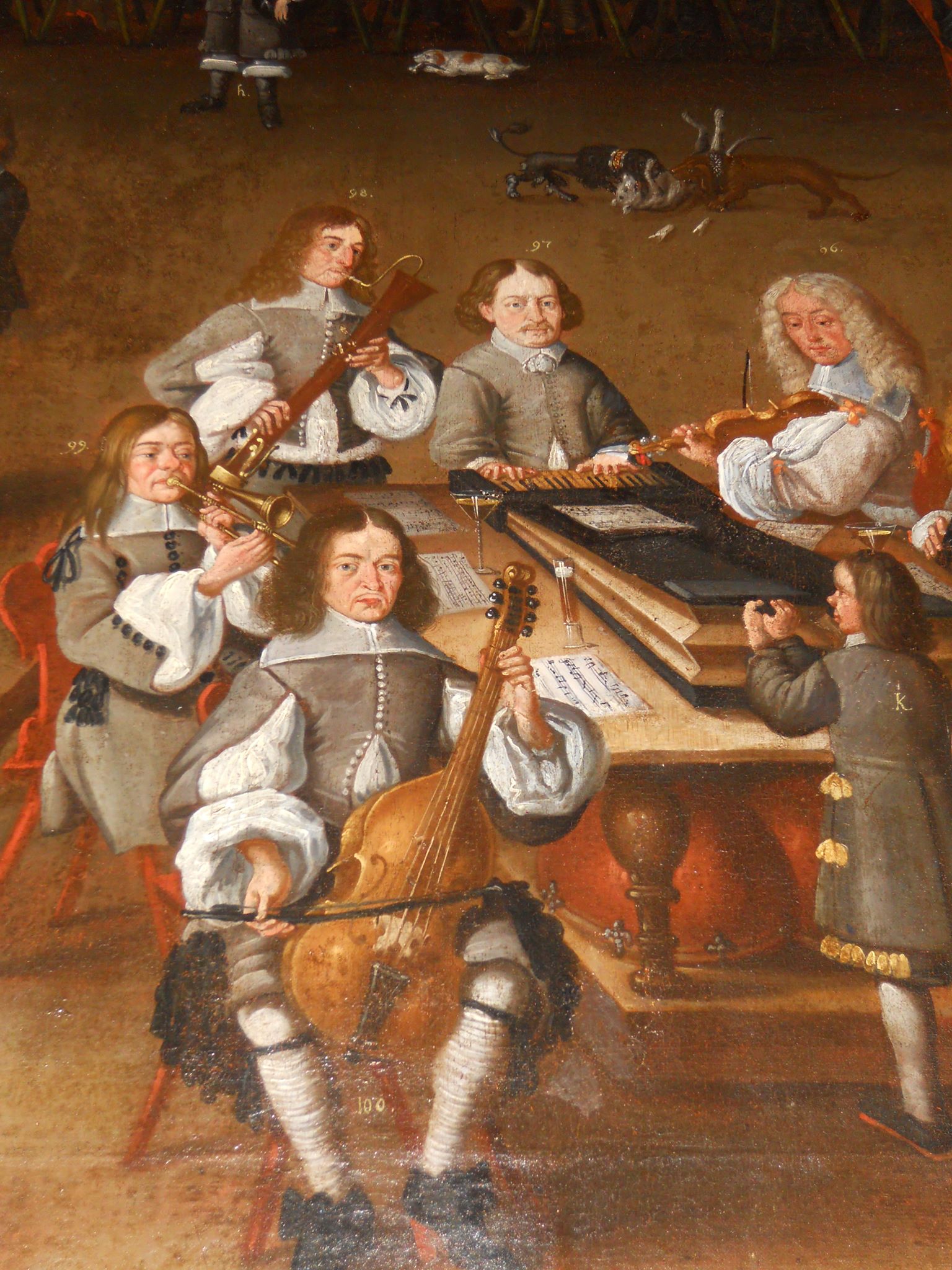
1658—Schöningen, Germany: Jonas Weigel completes the organ for St. Vincenzkirche, which includes a sculpture of an angel-trombonist on the organ case. The angel-musician on the opposite side plays the cornetto (see detail and full image, below; public domain).

1658—Naumburg, Germany: An inventory of musical instruments at St. Wenzel’s Church includes “mouthpieces for trumpets and trombones” (”Mundtstücke für Trompeten und Posaunen”) (Boydell, Crumhorn 96).
1658—Germany: An official government document called The Confirmation of Imperial Privileges states that trumpets may only be used for royalty (“the Emperor, Kings, Electoral and Imperial princes, counts and lords of knightly rank, and similar persons of quality”), not by the town musicians or others, further stipulating, “…nor shall they [the non-certified] use them—and certainly not trombones as if they were trumpets—for processional fanfares [Aufzüge], dances [or] blowing alarms…” (Collins).
1658—Johann Rudolph Ahle scores for bass voice, viola or trombone, violone or trombone, and basso continuo in Herr, nun läst du deinen Diener (Leonard, The Role of the Trombone…Mid- and Late Seventeenth Century).
1658—Johann Rudolph Ahle scores for soprano, alto, and tenor voice; 3 flutes or violins; flute or trombone or violone; and basso continuo in Seht euch für den falschen Propheten (Leonard, The Role of the Trombone…Mid- and Late Seventeenth Century).
1658—Johann Rudolph Ahle scores for voices, trombone or bassoon or viola, trombone or bassoon, 2 bassoons, and basso continuo in Fürchtet euch nicht (Leonard, The Role of the Trombone…Mid- and Late Seventeenth Century).
1658—Johann Rudolph Ahle scores for voices, 2 violins, 2 violas or trombones, 2 flutes, 2 trombones, and basso continuo in Meine Seele erhebet den Herren (Leonard, The Role of the Trombone…Mid- and Late Seventeenth Century).
1658—Johann Rudolph Ahle scores for SATB, 2 violins, 3 trombones, and basso continuo in Erschienen ist der herrliche Tag (Leonard, The Role of the Trombone…Mid- and Late Seventeenth Century).
1658—Johann Rudolph Ahle scores for voices, 3 trombones or violas, “trombone majore,” and basso continuo in his Magnificat (Leonard, The Role of the Trombone…Mid- and Late Seventeenth Century).
1658—Briegel scores for voices, 2 cornetti, 4 trombones, and basso continuo in his Nun lob mein Seel (Leonard, The Role of the Trombone…Mid- and Late Seventeenth Century).
1659—Rostock, Germany: The title page of Heinrich Müller’s collection, Geistliche Seelen-Music, features an engraving of numerous angel musicians, including one playing trombone (see below image; public domain).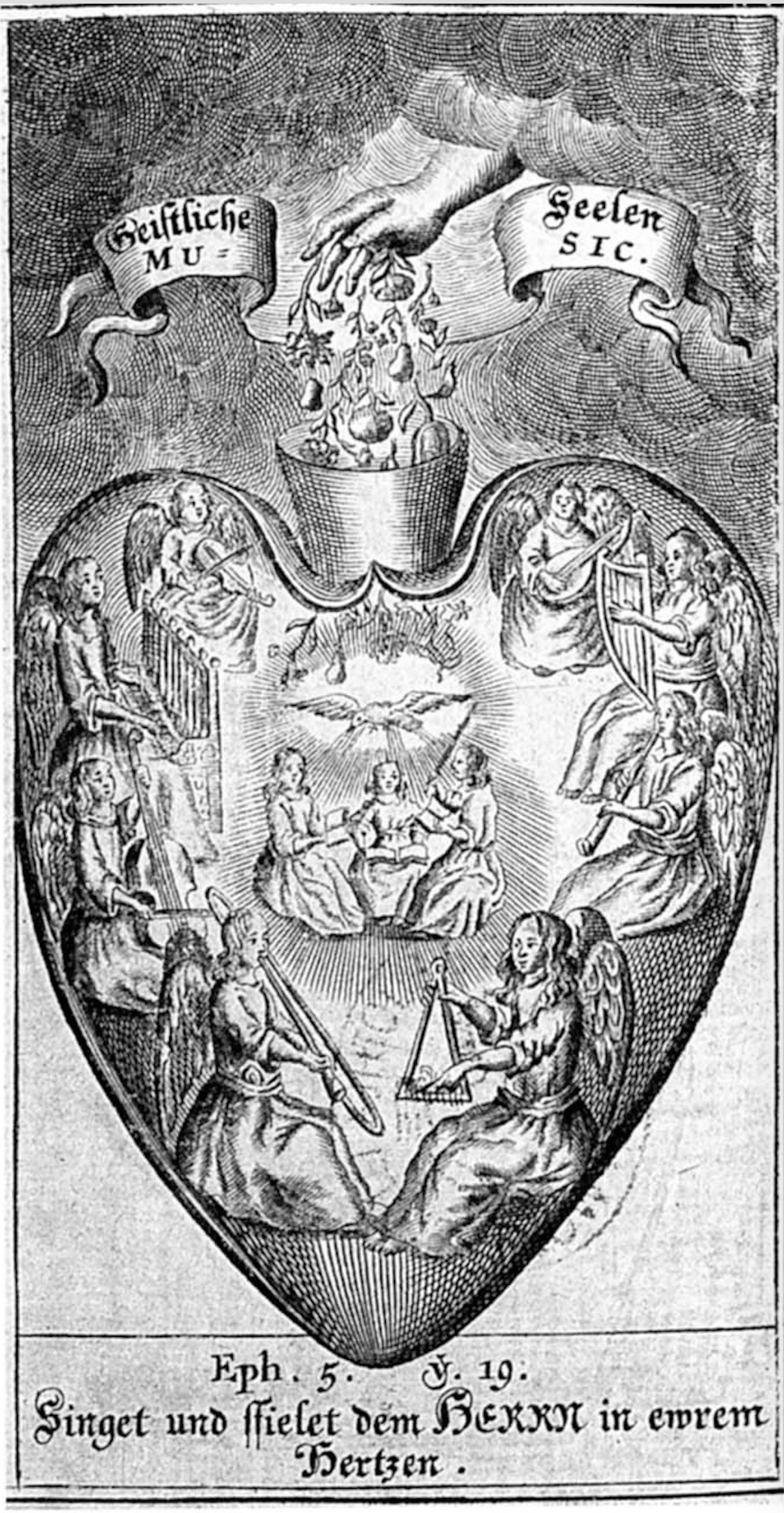
1659—Germany: Andreas Hammerschmidt writes Jauchzet ihr Himmel, which contains a Sinfonia for 3 trombones and 2 cornetts (Whitwell, Catalog Baroque 129).
c. 1660-70—Rome, Italy: Pierre Paul Sevin’s watercolor drawing of a performance of a mass for 4 choirs includes what appears to be a group of 3 trombones, including at least one rear-facing instrument (see detail and full image below; click image to expand; public domain images) (Nationalmuseum, Stockholm) (Bjurström, Feast and Theatre 60).

c. 1660—Germany: Andreas Hammerschmidt writes numerous sacred vocal works, at least 24 of which call for 4 trombones (Whitwell, Catalog Baroque 128).
1660—Vienna, Austria: Johann Sebastian Müller, a Saxon diplomat, sightseer, and diarist, visits Vienna, where he attends the “clothing and introduction ceremony” of an imperial Kammer-Fräulein (lady-in-waiting) at the Königinkloster. As part of the ceremony at the church, “instrumental music was performed with four choirs of instruments: one with violins, theorbos, and violas da gamba; a second with trombones and cornetti; a third with trumpets and timpani; and the fourth with high trumpets” (Page, Convent Music 19).
1660—Rome, Italy: By this date, Rome’s civic wind band is enlarged from its earlier size of 4 trombones and 2 cornetts (see, for example, 1600) to 5 trombones and 4 cornetts (Kurtzman, Trombe).
1660—Jacob Melani utilizes 3 cornetts and a trombone in his opera, Ercole in Tebe (Weaver, Sixteenth-Century Instrumentation).
1660—London, England: Records for the household of King Charles II include sackbut players among “musicians in ordinary to his Majesty.” They also note a “Warrant to pay John Strong, his Majesty’s musitian upon the wind instruments, the sum of 30 pounds, for two double sackbuts for service in his Majesty’s Chappell” (De Lafontaine 128).
1660—Modena, Italy: Marco Uccellini scores for trombone and violin in Sonata Decima Terza (Winkler 304; Selfridge-Field, Instrumentation).
1661—London, England: An instrument called a double sackbut is bought for his Majesty’s Chapel Royal (Ashbee, Records I 21).
1661—England: Matthew Locke (c. 1621-1677) composes Music for his Majesty’s Sagbutts and Cornetts, possibly for the coronation of Charles II. The music is a suite of pieces for 2 cornetts and 3 trombones (Herbert, Sackbut 79; Collver 58).
1661—Windsor, England: At the festival of St. George at Windsor, “…the hymn was composed and set with verse and chorus by Capt. [Henry] Cook—by whose direction some instrumental loud musick was at that time introduced, namely, two double sackbuts and two double courtalls—one sackbut and courtal before the four petty canons who began the hymn, and the other two immediately before the prebends of the College” (Whitwell, Baroque 198).
1661—Venice, Italy: Instrumental inventories at the Mendicanti conservatoire (orphanage) for the years 1661, 1670, 1673, 1682, 1700, and 1707 list several trombones (Baldauf-Berdes 171).
1661-66—Valletta, Malta: Artist Mattia Preti includes an angel-trombonist in his fresco on the apse of San Giovanni (see below image; public domain) (photo by Alfred Gouder).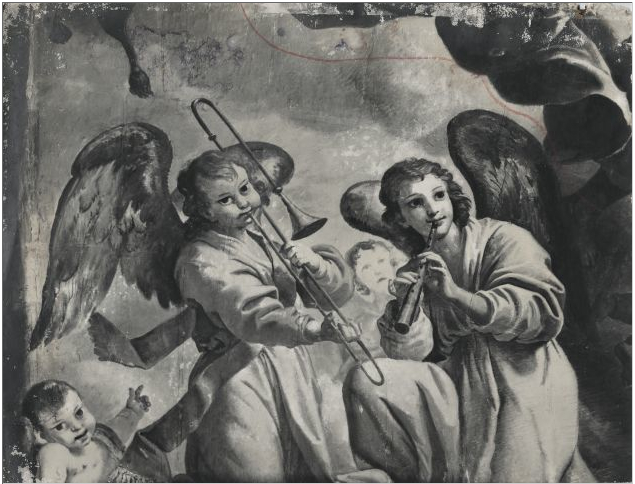
1662—Oslo, Norway: Reverend Christen Staffensön Bang writes “In our Lutheran churches a goodly number of musical instruments are used, especially on major holidays and whenever people of the upper class hold their wedding service. On these occasions instrumental music is played using organ, trumpets, trombones, zithers, violins, etc. And in this way singers and instrumentalists alike join together in praising and serving God as best they can” (Grinde 44).
1662—Vienna, Austria: Antonio Bertali’s (1605-1669) Sonata S. Leopoldi a 14 calls for 4 trombones (Collver 44).
1662—Vienna, Austria: Leopold I writes Domine Jesu Christe, which calls for 2 trombones (Collver 132).
1662—Zittau, Germany: Andreas Hammerschmidt scores for soprano voice, 2 trombette, 4 trombones, violone, and basso continuo in Nun lob mein Seel (Leonard, The Role of the Trombone…Mid- and Late Seventeenth Century).
1662—Zittau, Germany: Andreas Hammerschmidt scores for alto voice, 2 clarinos, 4 trombones, violone, and basso continuo in Herr hadre and Gelobet systu Jesu Christi (Leonard, The Role of the Trombone…Mid- and Late Seventeenth Century).
1662— Zittau, Germany: Andreas Hammerschmidt scores for voices, 2 violins, 3 trombones, and basso continuo in his Missa XIII (Leonard, The Role of the Trombone…Mid- and Late Seventeenth Century).
1662—Germany: Johann Michael Nicolai’s Sonata a 2 in G is included in the Partiturbuch Ludwig.
https://www.youtube.com/watch?v=GR3PaNkFN_4
1663—Augsburg, Germany: Artist Franz Friedrich Franck (1627-1687) displays a trombone prominently in his painting, Musikstilleben (Music Still Life) (see below image; public domain).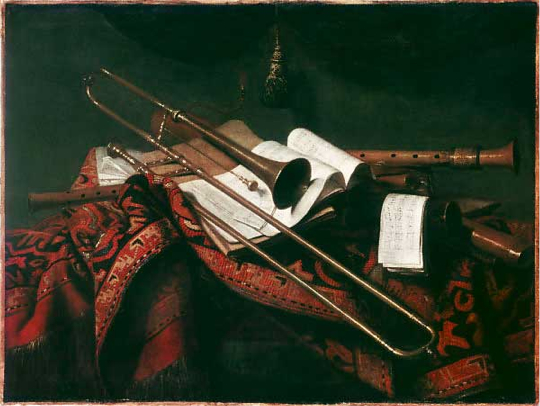
1663— Zittau, Germany: Andreas Hammerschmidt scores for voices, 2 violins, 4 trombones, and basso continuo in his Missa XVI (Leonard, The Role of the Trombone…Mid- and Late Seventeenth Century).
1663—Celle, Germany: According to a written proposal, the Hofkapelle consists of 13 musicians, including a player of either trombone or bassoon (Schulze, Johann Sebastian Bach’s Orchestra).
1663—Bologna, Italy: Estimates for the performers at the feast of San Petronio include 3 trombones: 2 “regulars” and another “extra” (Schnoebelen, Performance Practices at San Petronio, 43).
1663—Nuremberg, Germany: Manufacture date of an alto trombone by Michael Nagel of Nuremberg, one of the earliest extant models. Pitched in E-flat, it is labeled “Macht Michael Nagel, Nurnb., 1663” and features a detachable stay on the bell, with tubular stays on the slide (possibly added at a later date). Less ornate than many older trombones, the instrument may mark the beginning of a trend of Nuremberg manufacturers toward more utilitarian appearance of instruments. The instrument is held at Horniman Museum in London (Carse, Collection 68; Gregory 35, 52).
1663—London, England: Payment records for musicians of King Charles II include sackbuts (De Lafontaine 163).
1663—London, England: Musicians working for King Charles II, including sackbuts, are exempted from paying 4 different taxes levied by the Parliament (Ashbee, Records I 50). In 1667, a similar document exempts the musicians from paying “the poll money granted in the Parliament” (Ashbee, Records I 77).
1663—Johann Rudolph Ahle scores for voices, 2 violins, 2 trombette, 2 cornetti, 2 trombones, 2 flauti, and basso continuo in Sie ist fest gegründet (Leonard, The Role of the Trombone…Mid- and Late Seventeenth Century).
1664—Sandomierz, Poland: An endowment from Archdeacon Sebastian Kokwinski results in a vocal-instrumental chapel in the collegiate church in Sandomierz that includes a trombonist (Przybyszewska-Jarminska, The History of Music in Poland: The Baroque, Part 1, p. 99).
1664—London, England: A warrant encompassing trombone playing is drawn up “for the apprehension of all persons professing the art and science of music, playing at any playhouses, gamehouses, taverns, victualling houses, or any place in the city of London and Westminster, without the approbation and licence of the Marshall and Corporation of Musick” (Ashbee, Records I 55).
1664—Durham, England: Following the breaking of their voices, Alexander Shaw and Matthew Ridley transfer to sackbut and cornetto at the Durham Cathedral (Crosby, Durham Inventory).
1664—Heinrich Schütz writes his Christmas History, which includes a pair of trombones acting as obbligato instruments and specifically representing high priests (Smallman 151).
1664—Bernhard’s multichoral Benedic anima mea calls for 4 trombones (Leonard, The Role of the Trombone…Mid- and Late Seventeenth Century).
1664-1687—Mülhausen, Germany: Johann Rudolf Ahle’s Salamonisches Liebes Gespräch Komm meine Braut von Libanon calls for 5 trombones (Leonard, The Role of the Trombone…Mid- and Late Seventeenth Century).
1664-1695—Karl Liechtenstein, Prince-Bishop of Olmutz, states in a letter that he has 6 or 7 trumpets, 10 to 12 strings, and 8 or more trombones at his disposal at his residence (Kromeriz). A large amount of music with significant trombone parts is composed for this court by Biber, Vejvanovsky, Bertali, and others (Otto).
c. 1665—Durham, England: An inventory of the Durham Cathedral mentions “Two Sackbutts and Two Cornetts” (Crosby, Durham Inventory).
1665—Johann Rudolph Ahle’s sacred work, Höre, Gott mein Geschrey, calls for 5 tenor trombones and 2 bass trombones (Leonard, The Role of the Trombone…Mid- and Late Seventeenth Century).
1665—Johann Rudolph Ahle scores for voices, 2 violins, 4 trombones, and basso continuo in Zwingt die Saiten in Cithara (Leonard, The Role of the Trombone…Mid- and Late Seventeenth Century).
1665—Johann Rudolph Ahle scores for voices, 2 violins, 4 trombones, and basso continuo in Wie bin ich doch so herzlich froh (Leonard, The Role of the Trombone…Mid- and Late Seventeenth Century).
1665—Johann Rudolph Ahle scores for voices, 2 trombette, 3 trombones, and basso continuo in his Benedicamus (Leonard, The Role of the Trombone…Mid- and Late Seventeenth Century).
1665—Johann Rudolph Ahle calls for 4 trombones in his Gloria in excelsis Deo (Leonard, The Role of the Trombone…Mid- and Late Seventeenth Century).
1665—Vienna, Austria: Antonio Bertali’s Sonata Sublationis is copied. The work is written for 2 trumpets, 2 trumpets ad lib, 2 violins, 3 viols or trombones (notated respectively in alto, tenor, and bass clefs), and continuo (Bertali, Sonata Sublationis).
1665—A print on the title page of Hector Mithobius’s Psalmodia Christiana portrays trombone, lute, harp, cornet, bassoon, viol, and organ performing in a sacred setting. The trombone is on the far right (see below image; public domain).
1666—Cesti employs 3 trombones, 2 cornetts, a bassoon, and a regal in the opera Il Pomo d’oro (Weaver, Sixteenth-Century Instrumentation).
1666—Bologna, Italy: 5 trombones from Concerto Palatino, the city wind band, are admitted to the prestigious Accademia Filarmonica (Guion, Missing Link).
1667—France: Mort d’Amnon, fils de David, a print by Jean Le Pautre, shows a trombone playing with a group of musicians from a raised platform or balcony (see detail and full image below; public domain) (French National Library).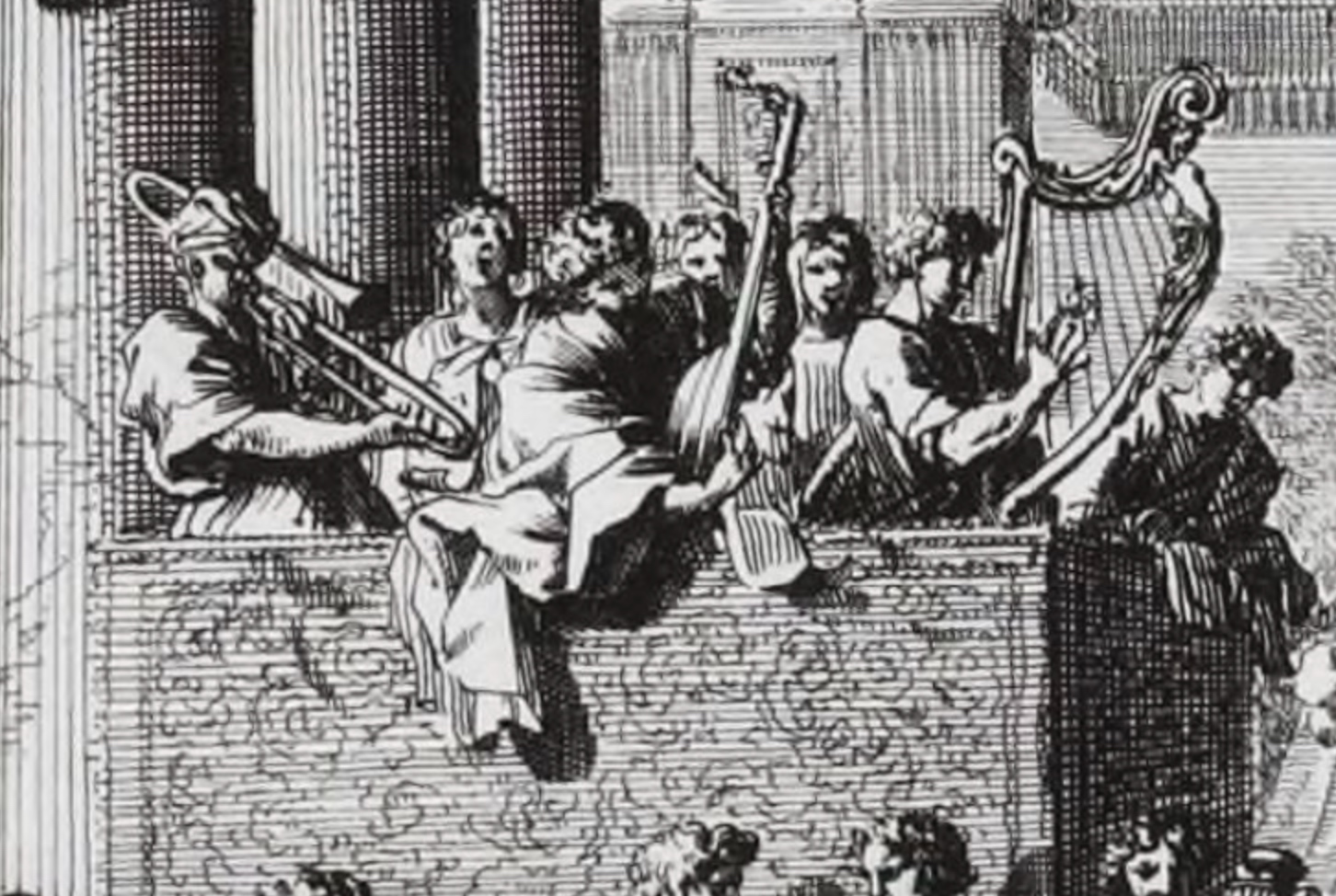
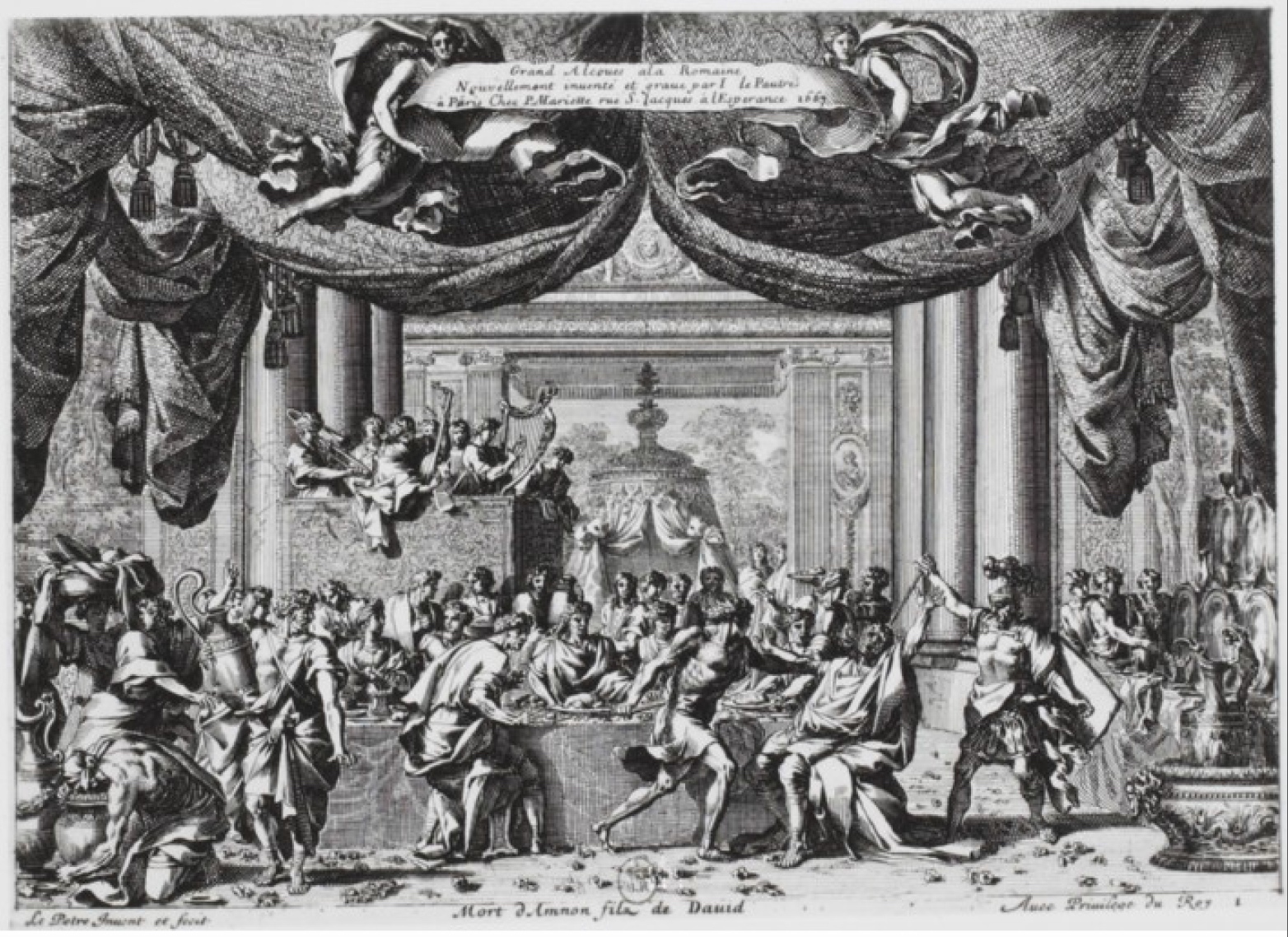
1667—Bologna, Italy: A record of events surrounding the yearly celebration of the Battle of Fossalta mentions trombones: “And if the harmonious music was continually followed by the sweetest symphonies, the end of the action was similarly followed by a boisterous but pleasing noise of trumpets, timpani, corni da caccia, trombones, cornetti, and I must say an infinity of wind instruments” (Allsop, Secular Influences).
1667—England: Payment records for musicians of King Charles II include hoboyes and sackbuts (De Lafontaine 195).
1667—Martin Schneider writes Erster Theil. The collection contains several works for the following instrumentation: soprano voice, alto trombone, tenor trombone, 2 trumpets (or cornettinos or violins), violone or trombone, and continuo (Collver 166).
1667—Vienna, Austria: Cesti’s Pomo d’oro calls for calls for trombone, particularly in Act I, Scene I, set in the underworld. The instrumentation in the scene is 2 trombones, 2 cornetts, and a continuo of trombone, bassoon, and regal organ (Rose, Agazzari and the Improvising Orchestra).
c. 1668—Kroměříž, Czech Republic (then Moravia): Correspondence from Karl II von Liechtenstein-Kastelkorn, Prince-Bishop of Olomouc (Olmütz), says that he can provide the Viennese court “six or seven clarini, ten to twelve strings [geigen] and seven, eight or more trombones” (Chafe, Church Music 8).
1668—Essingen, Germany: An organ is installed in the evangelische Kirche. At around the same time, the painted panels on the front of the balcony, one of which appears to depict a trombonist, are installed (see detail and full image below; public domain) (Völkl 41).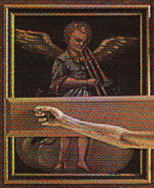
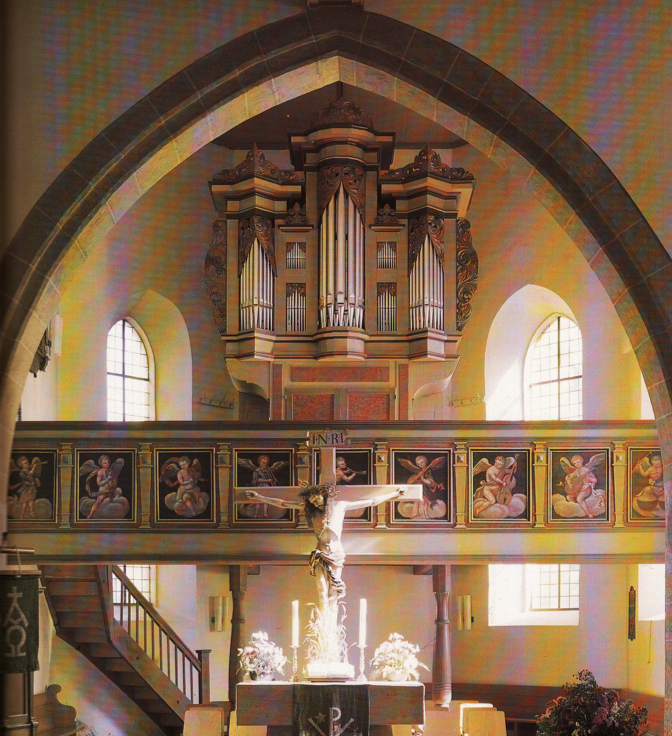
1668—Manufacture date of bass trombone made by Hans Hainlein of Nuremberg and held at Musée Instrumental, Brussels (Gregory 50).
1668—Heinrich Biber writes Intrada for 6 trumpets, 3 trombones, and timpani (Whitwell, Catalog Baroque 2).
1668—Vienna, Austria: Johann Joseph Fux writes Missa S. Ignatij and Missa Augusta, both of which call for 4 trombones (Collver 116).
1668—Marc’ Antonio Cesti uses trombones in Il pomo d’oro, an extensive, 8-hour opera performed for the birthday of Margherita of Spain, wife of Holy Roman Emperor Leopold I (Guion, Short History).
1668—Modena, Italy: Marco Uccellini calls for trombone in a collection of his works (Selfridge-Field, Instrumentation).
1668—Venice, Italy: Pietro Andrea Ziani’s Sonata XX is scored for 2 violins, alto or tenor viola, and 2 trombones or 2 violas (Winkler 304).
1668-93—Passau, Germany: Carpoforo Tencalla’s fresco in St. Stephan’s Cathedral includes depictions of many angel-musicians, including a trombonist (see below detail; public domain) (Crombie 50).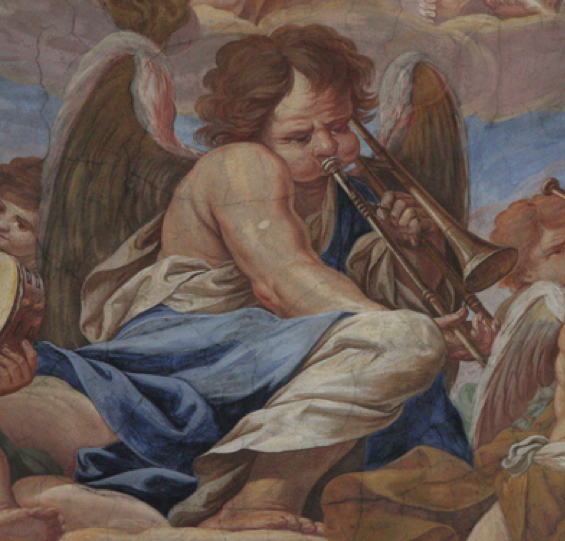
1669—Leipzig, Germany: Johann Pezel writes a now-lost collection, Decas Sonatarum, of 6-part pieces for 4 trombones and 2 cornetts (Collver 188; Whitwell, Baroque 158).
1669—Leipzig, Germany: Johann Pezel writes Missa a 10 & 15, which call for 3 trombones (Collver 146).
1669—Vienna, Austria: Johann Heinrich Schmelzer, Sonata “La Carioletta” for cornetto, violin, trombone, and bassoon (Collver 68).
1669—Vienna, Austria: Antonio Bertali (1605-1669) writes Missa Resurrectionis, which calls for 5 trombones, Missa Archiducalis, which calls for 4 trombones, and Sonata a 13, which calls for 3 trombones (Collver 44, 90).
1669—Gotha, Germany: Wolfgang Carl Briegel writes Intraden und Sonaten, a collection of 4-part and 5-part works for cornetts and trombones, now lost (Whitwell, Catalog Baroque 121).
1669— Tópaga, Colombia: The terno, or “set” of wind players, consists of trombone (sacabuche) and 3 shawms (Bermúdez).
1669—Nuremberg, Germany: Nürnberger Stadtmusikanten, an illustration by Johann Kramer, includes a brass instrument that is probably a trombone. The back bow of tubing extends past the player’s head, and the slide extends slightly past the bell (see below image; public domain) (German National Museum, Nuremberg).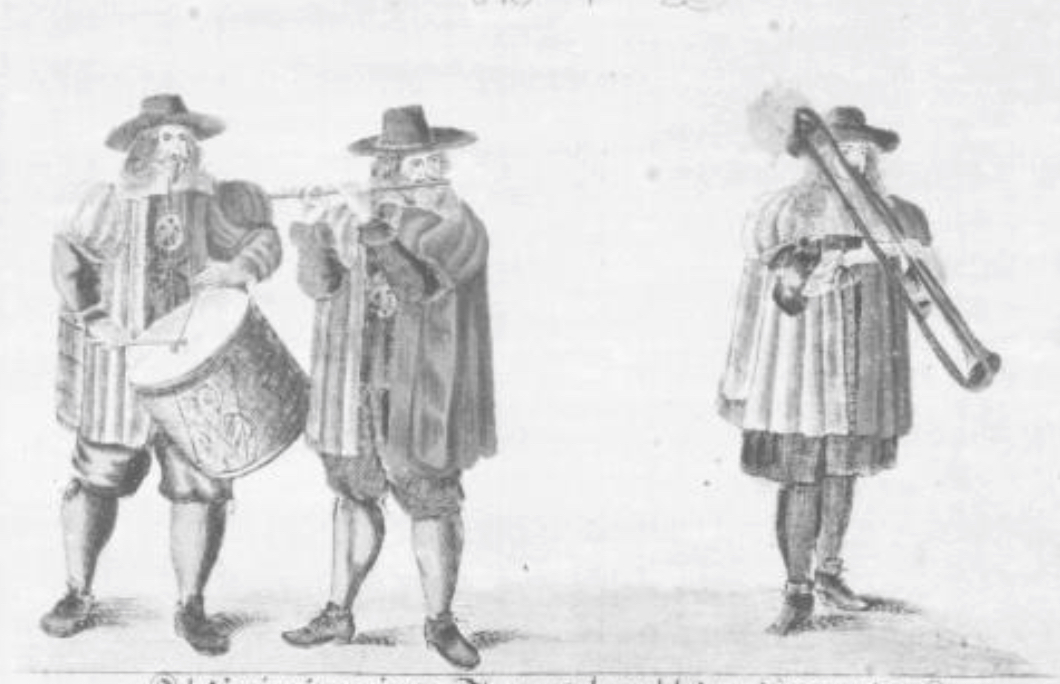
c. 1669—Anonymous sonata for trombone and basso continuo written by monk in St. Thomas monastery, Bohemia. Earliest known composition originally written and specified solely for the trombone.
c. 1670—Italy: Bartolomeo Bettera’s Still Life with Musical Instruments includes a trombone in the center of the image (see below image; public domain).
1670—An anonymous sonata, titled Sonata per la camera e chiesa, calls for 2 violins, 2 cornetts, 3 trombones or violas, and organ (Collver 40).
1670—Danzig: A contemporary description of wedding festivities describes music played from the tower of the town hall: “with the drums which first played on their own for a while, after which the trumpets joined in, and then the trombones (posaunen), Storten and cornetts” (Boydell, Crumhorn 135).
1670—Leipzig, Germany: Johann Pezel is promoted to Stadtpfeifer. Shortly thereafter, he produces Hora decima, a collection of 40 single-movement sonatas for 5-part cornetto-trombone ensemble (Downs, Tower Music).
1671—Altenberg, Germany: The court trumpeters (Kammeradschaft) lodge a complaint against the trombonists and other civic musicians for imitating the sound of the trumpet on their instruments. The city fathers, in turn, defend the civic players thus: “[The civic players] used their instruments, such as trombones, cornetts, also violins [and] viola, according to the music, as well as they could in all places for celebrations, weddings, and other honorable gatherings. It is also customary everywhere that they perform, from the music set down, on the instruments discussed here, and if town’s people and other music lovers requested a tune in the manner of trumpets on trombones, cornetts and violins, they could not help but oblige them as best they could in this way. All of which has been customary here and in other places according to their art for countless years” (Collins).
1671—Vienna, Austria: Johann Heinrich Schmelzer (1623-1680) calls for 2 trombones in his Missa tarde venientium (Collver 165).
1671—Trombone is called for in Paul Konwalynka’s Musicalische Neu-Jahrs Beehrung (Collver 128).
1672—Lübeck, Germany: In his application for a position as a municipal musician, Hans Iwe writes that “in the beginning I learned to play music on all kinds of instruments from Hinrich Höpfener, a municipal musician here….I do not hesitate to play violin, viola da gamba, violone, all manner of woodwinds, cornetto, dulcian, trombone, bass trombone and flutes in a suitable manner; also if necessary I can serve with keyboard and vocal music” (as quoted in Snyder, Buxtehude revised 51).
1672—Salzburg, Austria: Frans de Neve’s Allegory of Fame, located in the ceiling of the Schöne Galerie of the Residence State Rooms, includes what appears to be a trombone (see below image; public domain) (special thanks to Richard Lyman).
1672—Salzburg, Austria: Abraham Megerle, fürsterzbischöflicher Kapellmeister in Salzburg from 1640 to 1651, publishes Speculum Musico-Mortuale, which contains copper engravings of many contemporary musical instruments, each plate featuring a skull as centerpiece. The third plate includes images of trombones labeled Busaun and Quartbusaun (see below image; public domain).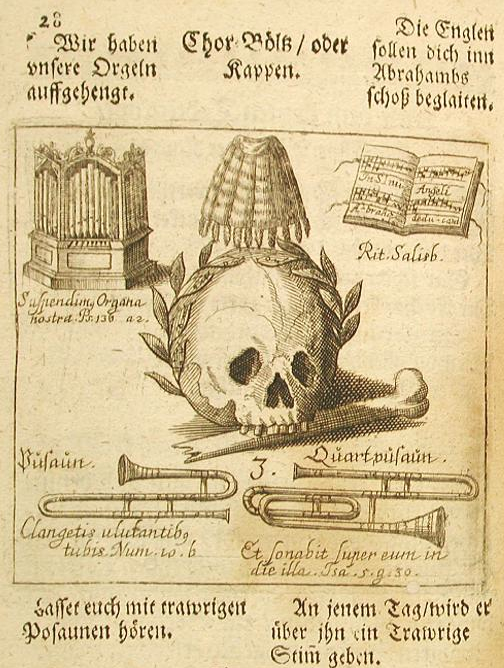
1672—Knüpfer calls for 4 trombones in Quare fremuerent gentes (Leonard, The Role of the Trombone…Mid- and Late Seventeenth Century).
1672—Christian Ritter calls for 3 trombones in his Gelobet sey der Name des Herren (Collver 156).
1672—London, England: A statement in “The Institution of the Order of the Garter” by Elias Ashmole records that “two double sackbuts and two double courtals” are “placed…among the…choirs, to the end that all might distinctly hear” (Langwill, Curtal).
1673— Pátzcuaro, Mexico: Diego Basalenque reports that Pátzcuaro has become a center for the making of instruments, including sacabuches (Stevenson, Music in Aztec 199).
1673—Salzburg, Austria: A poem written and set to music by Father Romanus Müller describes the instrumental forces probably perceived as necessary for playing ad pulpitum (on the musicians’ balconies). Among the specific instruments listed is trombone (Chafe 39).
1673—Salzburg, Austria: Heinrich Biber calls for 3 trombones (the only winds in the piece) in his Lux Perpetua (Chafe 87, 237).
1673—Vienna, Austria: Leopold I, second son of Emperor Ferdinand III, Holy Roman Emperor, composes Missa pro defunctis, probably for the death of his first wife. The piece calls for 2 trombones (Chase 120).
1674—Augsburg, Germany: A decorative platter by goldsmith Hans Jakob Mair depicting the “Apotheosis of Arts and Sciences” includes a figure playing what may be a trombone (see detail and full image below; public domain) (Royal Museum of Art and History, Brussels, in BALaT: Belgian Art Links and Tools).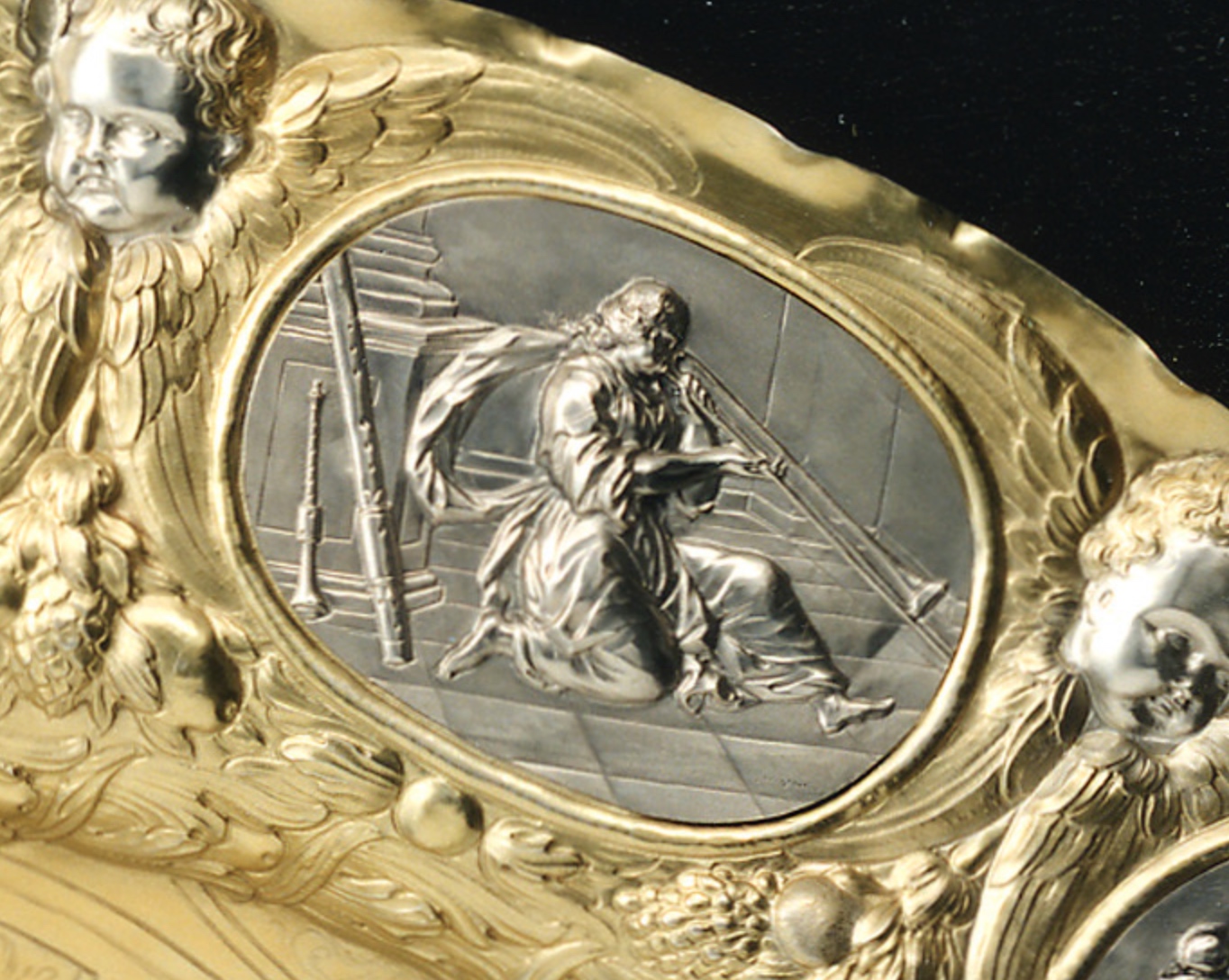
1674—Lübeck, Germany: St. Mary’s, employer of the influential organist and composer Dieterich Buxtehude, purchases two diskant Posaunen. This name (diskant Posaune) had been given by Praetorius several decades earlier as a name for the alto trombone, which he clearly depicts as a smaller, shorter instrument (see 1620 for Praetorius) (Snyder, Buxtehude revised 379).
1674—Becker scores for voices, 2 violins or trombette, 2 trombones or violas, trombone or bassoon or violone, and basso continuo in Das Blut Jesu Christi (Leonard, The Role of the Trombone…Mid- and Late Seventeenth Century).
1674—Windsor, England: At a religious service an observer notes, “There were placed in the middle of the Choristers two Cornets & behind them a Sackbote, & last of all a Sackbut…& Doctor Child the Organist alone in his Doctors habit” (Whitwell, Baroque 198).
1674—Salzburg, Austria: Heinrich Biber’s polychoral mass, Missa Christi Resurgentis, calls for 3 trombones (Chafe 84, 234).
1674—Salzburg, Austria: Heinrich Biber’s Vesperae a 32 calls for 3 trombones (Chafe 119).
1674—Vienna, Austria: Wolfgang Ebner composes Missa in Contrapuncto for choir, cornetto, organ, and 3 trombones (Whitwell, Catalog Baroque 2).
1674—Johann Heinrich Schmelzer’s “Balletto di Centauri, Ninfe et Salvatici,” for 3 choirs, includes a choir of “2 Cornetti muti et 3 Tromboni” (Holman Violin 251).
1674—Composer Martin Mayer writes a vocal work called Hosianna dem Sohne David, which calls for 3 trombones (Collver 136).
1674-80—Cuzco, Peru: An anonymous painting, Confraternities of Saint Rose and La Linda, part of a group of paintings called The Procession of Corpus Christi, depicts an Andean trombonist among several wind players. The musicians accompany the statue of Saint Rose as part of a long procession through the streets of Cuzco. The trombonist has what appears to be a decorative red bow tied to the end of the slide, as well as a white cord around the rear portion of tubing (see detail and full image below; click full image to expand; public domain) (Cuzco, Museo del Arzobispo) (Wuffarden pl. 14; Baker, Imposing Harmony 38; Baker, Music at Corpus Christi).
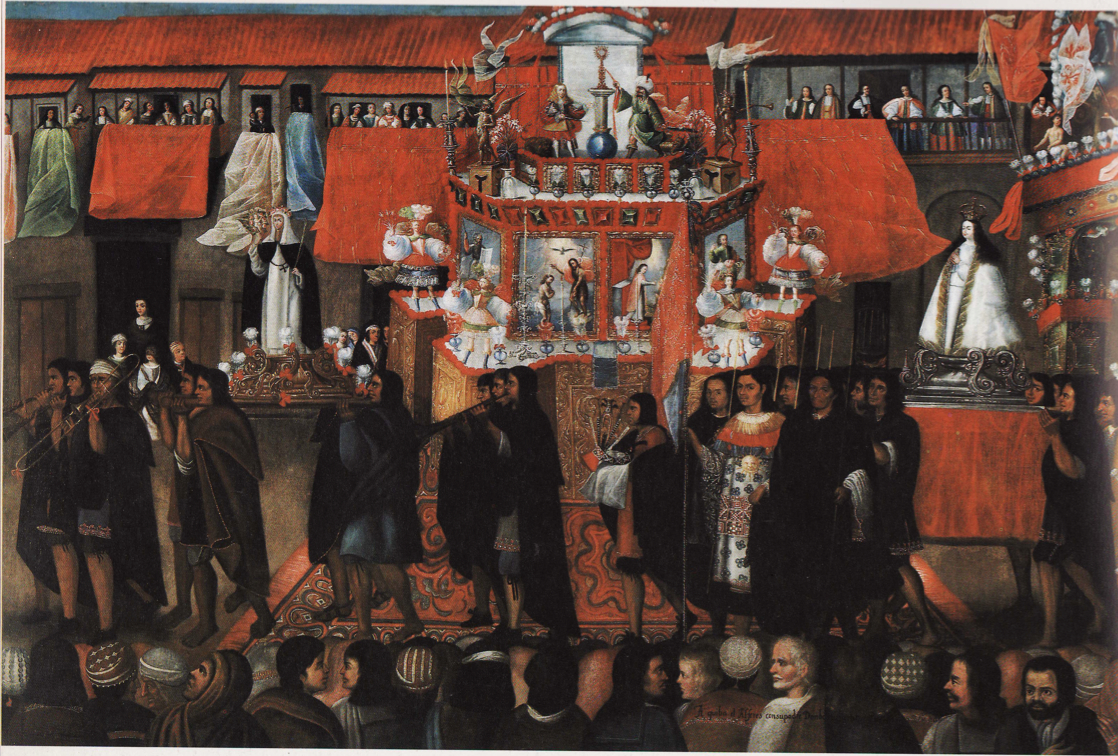
1674-1695—Bologna, Italy: During the period that Giovanni Paolo Colonna is maestro di cappella at San Petronio, the maximum number of trombones employed in the regular chapel is 2 (Schnoebelen, Performance Practices at San Petronio, 42).
c. 1675—Rome, Italy: A small group of musicians in the church Santi Ambrogio e Carlo includes an angel playing what appears to be a trombone with a bent slide and missing bell (see below image; public domain).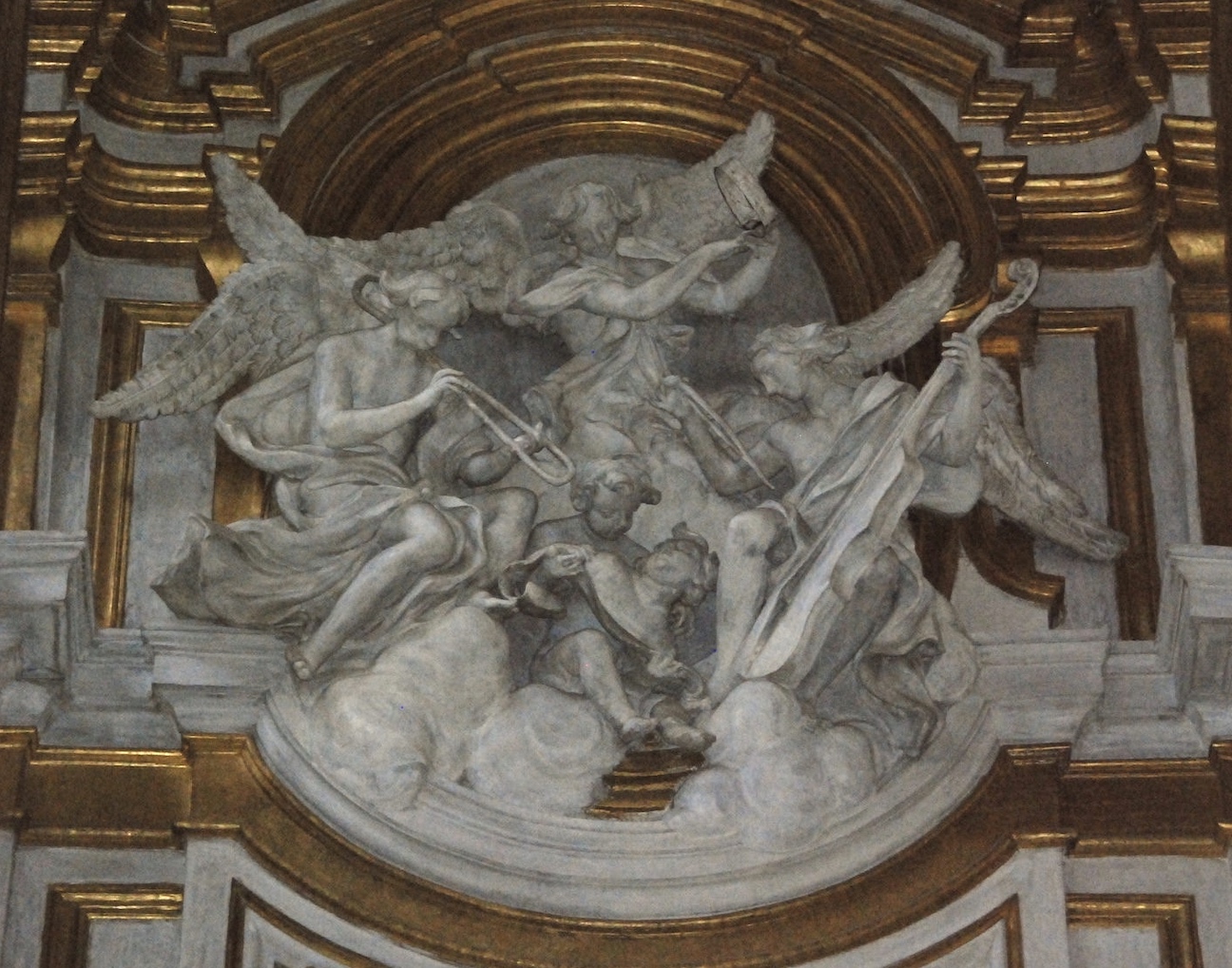
c. 1675—Bern, Switzerland: The title page of Johann Ulrich Sultzberger’s book of transposed Psalm settings, Dr. Ambrosii Lobwassers Psalmen Davids, features an image with a trombone and cornetto suspended together (see upper-middle of below image; public domain). Special thanks to Bruce Dickey.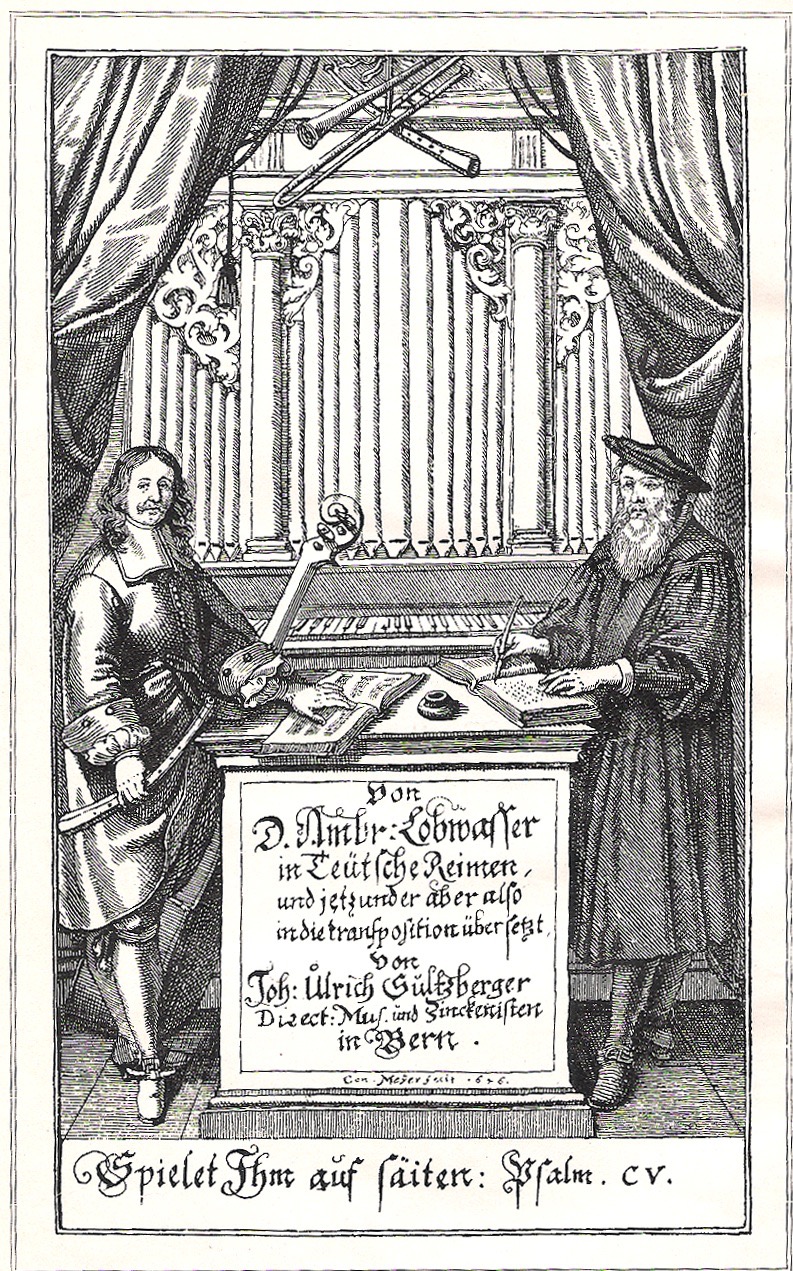
c. 1675—Poland: Stanislaw Sylwester Szarzynski’s Gloria in excelsis Deo calls for an instrumental accompaniment of 2 violins and 3 trombones (labeled Trombone Alto, Trombone Tenore, and Trombone Basso e Viola) (Przybyszewska-Jarminska, Baroque part I, 322).
c. 1675—Johann Rosenmüller calls for 5 trombones in his Als der Tag der Pfingsten erfüllet war (Leonard, The Role of the Trombone…Mid- and Late Seventeenth Century).
c. 1675—Vienna, Austria: Johann Kaspar Kerll’s Missa a 3 cori, written for a performance at St. Stephen’s cathedral, includes a “Crucifixus” scored for 3 solo bass voices and trombones (Chafe 50).
c. 1675—Johann Rosenmüller calls for 5 trombones in his Nun gibst du, Gott, einen gnädigen Regen (Leonard, The Role of the Trombone…Mid- and Late Seventeenth Century).
c. 1675—Italy or Spain: Allegoria della musica, a painting by Luca Giordano, includes a trombone resting on a table (see below image; public domain) (special thanks to Tassos Dimitriadis).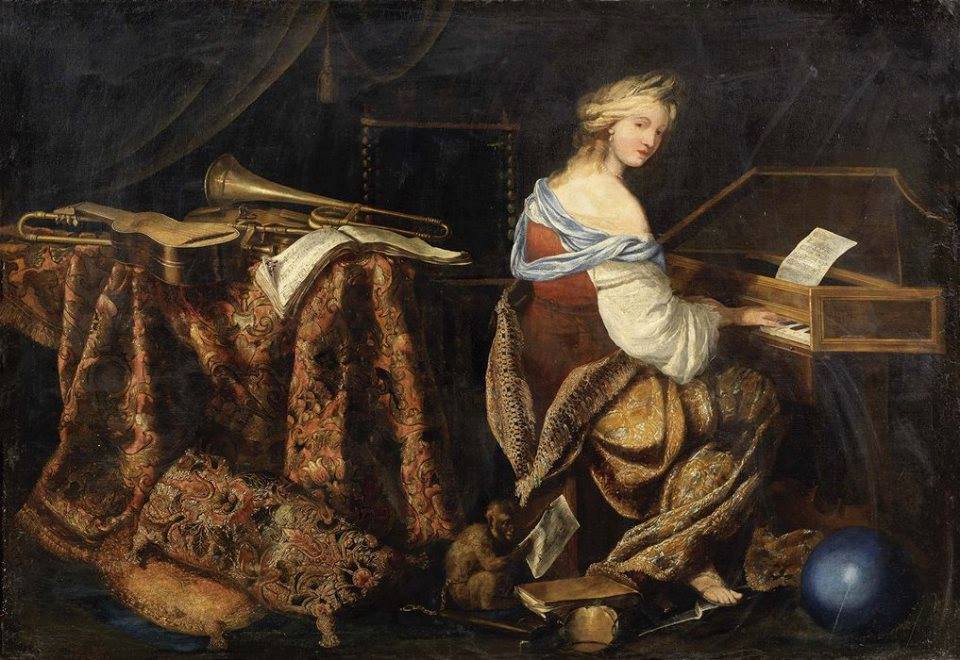
c. 1675—Montserrat, Spain: Virgen Montserrat, an oil painting by Agustí Renom, an artist living in Montserrat, includes a figure in the foreground playing trombone. The image bears a resemblance to several other Montserrat paintings that include trombone (see below image; public domain) (Esteve, Instrumentos Musicales en las Representaciones de la Virgen de Montserrat).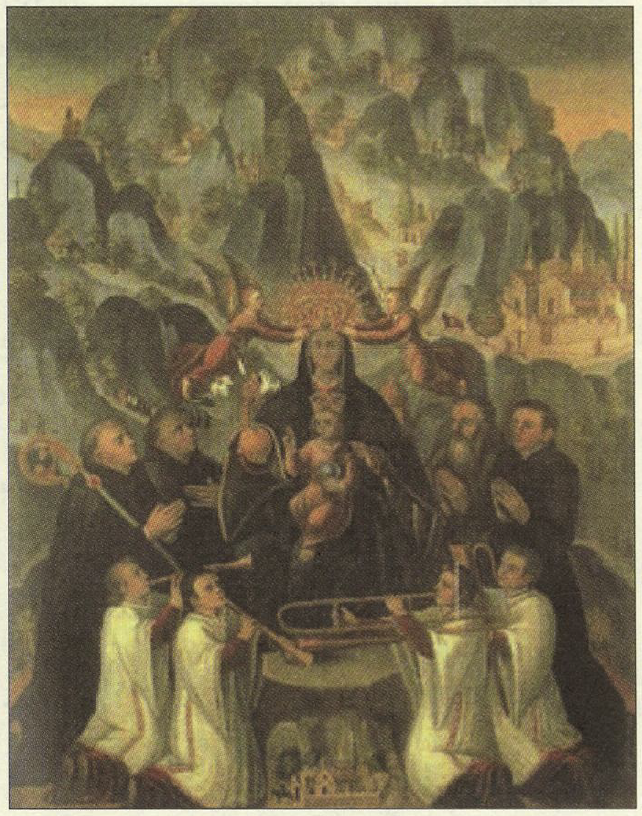
1675—Breslau, Poland: Martin Meuer’s Jubilate a 37 o 44, performed at the church of St. Mary Magdalen for an anniversary service, calls for 4 trombones in one of the 5 choirs (Chafe 50).
1675—Lübeck, Germany: Dietrich Buxtehude composes Sinfonia, in Ihr lieben Christen, freat euch nun, for 3 trombones and 3 cornetts (Whitwell, Catalog Baroque 122).
1675—Johann Heinrich Schmelzer’s “Sonata natalitia,” for 3 choirs, includes a choir of “2 Cornetti muti et 3 Tromboni” (Holman Violin 251).
1675—Venice, Italy: Francesco Cavalli, maestro di cappella at St. Mark’s, sensing that his life is drawing to a close, composes his Missa pro defunctic per octo vocibus for his own funeral. He leaves specific instructions that the instruments should consist of 2 violins, 4 violas, 2 cornets, 2 theoroboes, trombones, bassoon, bass viol, and 3 organs. The work is performed at his funeral a year later (Chase 106).
1676—Dresden, Germany: Artist David Conrad includes 3 trombones in his engraving of Dresden’s Schlosskapelle (see right side of detail below; click image to expand; public domain) (Die bemalten Orgelflügel 69).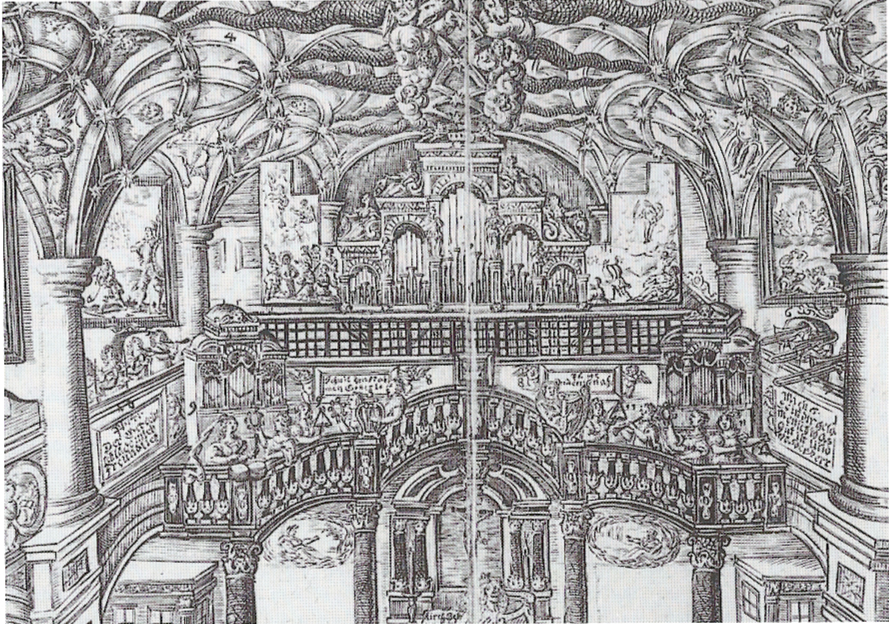
1676—Elisha Coles, in An English Dictionary, defines sackbut as simply “A drawing trumpet.” The term trombone is not listed (Coles).
1676—Vienna, Austria: Johann Heinrich Schmelzer (1623-1680) calls for 4 trombones in his Ad concentus o mortals ad triumphos (Collver 165).
1676—Durham, England: Roger North notes doubling of voices by cornetts and sackbuts at Durham cathedral: “They have the ordinary wind instruments in the Quires, as the cornet, sackbut, double curtaile and others, which supply the want of voices, very notorious there” (Wilson, Roger North 40). The above sentence is later altered before publication in 1742, either by North or his son Montagu, to read, “In these churches, wind musik was used in the Choir; which I apprehend might be introduced at first for want of voices, if not of organs; but, as I hear, they are now disused” (Wilson, Roger North 40).
1676—Rome, Italy: The pifferi of Rome changes from 5 trombones and 4 cornetts (see 1660) to 6 trombones and 3 cornetts. They perform during meals of the Conservatory and Priore, in church services, in religious processions, etc. (Kurtzman, Trombe).
1676—Leipzig, Germany: Johann Pezel composes music for a now-lost collection, Intraden, which consists of works for cornett and 3 trombones (Collver 188; Whitwell, Baroque 158).
1676—Gotha, Germany: A draft for a Kapelle at the court of Gotha calls for “one Kapellmeister; one singer each for bass, tenor, and alto; one falsettist; two boys; one very good organist; two violinists; and one trombonist or one harpist,” as well as “trumpeters, who will also provide music.” A proposal from Kapellmeister Mylius from the same year requests “two cornettists and three trombonists, who are likewise expected to perform capably on various string instruments” (Schulze, Johann Sebastian Bach’s Orchestra).
1676—Basel, Switzerland: A painting by an unknown artist on the ceiling of a castle/country manor house just outside Basel, now relocated to the “Gundeldinger Zimmer” at the Historisches Museum in Basel, features Minerva and the nine muses. Among the muses is one playing trombone (see below image; public domain; special thanks to Maximilien Brisson).
1676—Norwich, England: Although only 3 members of the town waits survive, they and the widows of the 2 deceased members have 5 sackbuts, 3 cornetts, and 3 hautboys in their possession (Whitwell, Baroque 170).
1676—London, England: A pastoral drama called The Parley of Instruments features characters discussing the virtues of various instruments, including “pipes, flutes, flageolets, cornetts, sackbuts, hautboys, recorders, organs and all sort of wind instruments” (Lasocki, Professional Recorder Playing).
1676—Vienna, Austria: Leopold I writes Parce mihi and Tres Lectiones I, both of which call for 2 trombones (Collver 132, 134).
1676—Composer Martin Mayer writes several vocal works that call for 3 trombones: Es wird dass Scepter von Juda, Schmecket und sehet wie freundlich, Heylig ist der Herre Zebaoth, Kommet her zu mir alle, and Ich wil mich mit dir verloben (Collver 136).
1677—England: Trombones participate in a procession on the Thames River for Lord Mayor’s Day, performing in consort with hautboys on a barge for the Goldsmiths’ Company. Court records show an agreement “for John Greenslade a Musitioner…with five others to attend this Company on the next Lord Maiors day with Hoboyes & Sackbutts.” Records also show trombones participating in similar processions in 1678 and 1679 (Wood, A Flowing Harmony).
1677—London, England: Francis North includes the following comment about trombone in his A Philosophical Essay of Musick: “In a Sackbut the Lips of a Man do the same office as a Quill does in a Shaume or Hautboys; when the included Air is lengthned, the Tone varies: nevertheless they can produce several Notes that are in Chord to the Tone of the Instrument, by strengthning the blast without lengthning the cavity” (North, Philosophical 6). North also remarks, “The Trumpet not being able to answer a flat Key, the Sackbut as I observed before is made in such manner that it may be lengthned to supply this defect, whereby it will give any Note at the pleasure of him that plays: but when he is to Sound an eighth or fifth above, he never lengthens the Instrument, for without any remove of his hand, the Note easily breaks into those higher Chords” (North, Philosophical 7).
1677—Mecklenburg, Germany: Cristiann Kofahl makes what is probably the earliest extant soprano trombone. The instrument is held in Schloss Kremsegg, Kremsmünster (Herbert, Trombone 313).
1677—Johann Rosenmüller writes Entsetze dich, Natur, which calls for an instrumental accompaniment of 2 violins, 2 cornettos, 3 trombones, and continuo (Collver 158).
1677—Vienna, Austria: Johann Heinrich Schmelzer (1623-1680) includes 3 trombones in his Missa Mater purissima (Collver 165).
1677—Vienna, Austria: Antonio Bertali (1605-1669) writes Missa Redemptoris, which calls for 5 trombones (Collver 90).
1677—Composer Martin Mayer writes Gott ist unser Zuversicht und stärcke; Freude! Jesus ist erstanden; and Ihr Lieben, gläubet nicht einem ieglichen Geiste, all ofwhich call for 3 trombones (Collver 136).
1677—Leipzig, Germany: Sebastian Knüpfer’s Der Herr ist König calls for 7 trombones, 5 tenors and 2 basses (Leonard, The Role of the Trombone).
1677—Mariana Islands: Among the musical items sent from Mexico to the Marianas, a group of islands under Spanish rule, are 3 shawms and one trombone (Irving 59).
1678—Vienna, Austria: Leopold I writes Stabat Mater, which calls for 2 trombones (Collver 132).
1678—Leipzig, Germany: St. Thomas’s church owns a “choir” of trombones (Terry 19).
1678—Date engraved on Grigoletti bell of valve trombone. Valves have not been developed at this time, and there is a strut connecting the bell and the upper bend of the horn, so the bell is thought to have been fitted to a valve trombone sometime much later (Young 218).
1678—Johann Rudolph Ahle scores for soprano voices, 2 trombette, 3 trombones, and basso continuo in his Freudenlied (Leonard, The Role of the Trombone…Mid- and Late Seventeenth Century).
1679—Certosa di Pavia, Italy: A fresco by Giuseppe Procaccini includes an angel playing what appears to be a trombone. Although the rear bow of tubing does not extend behind the player’s head as it should, the instrument appears to have a slide and the general configuration of a trombone (see detail and full image below; public domain).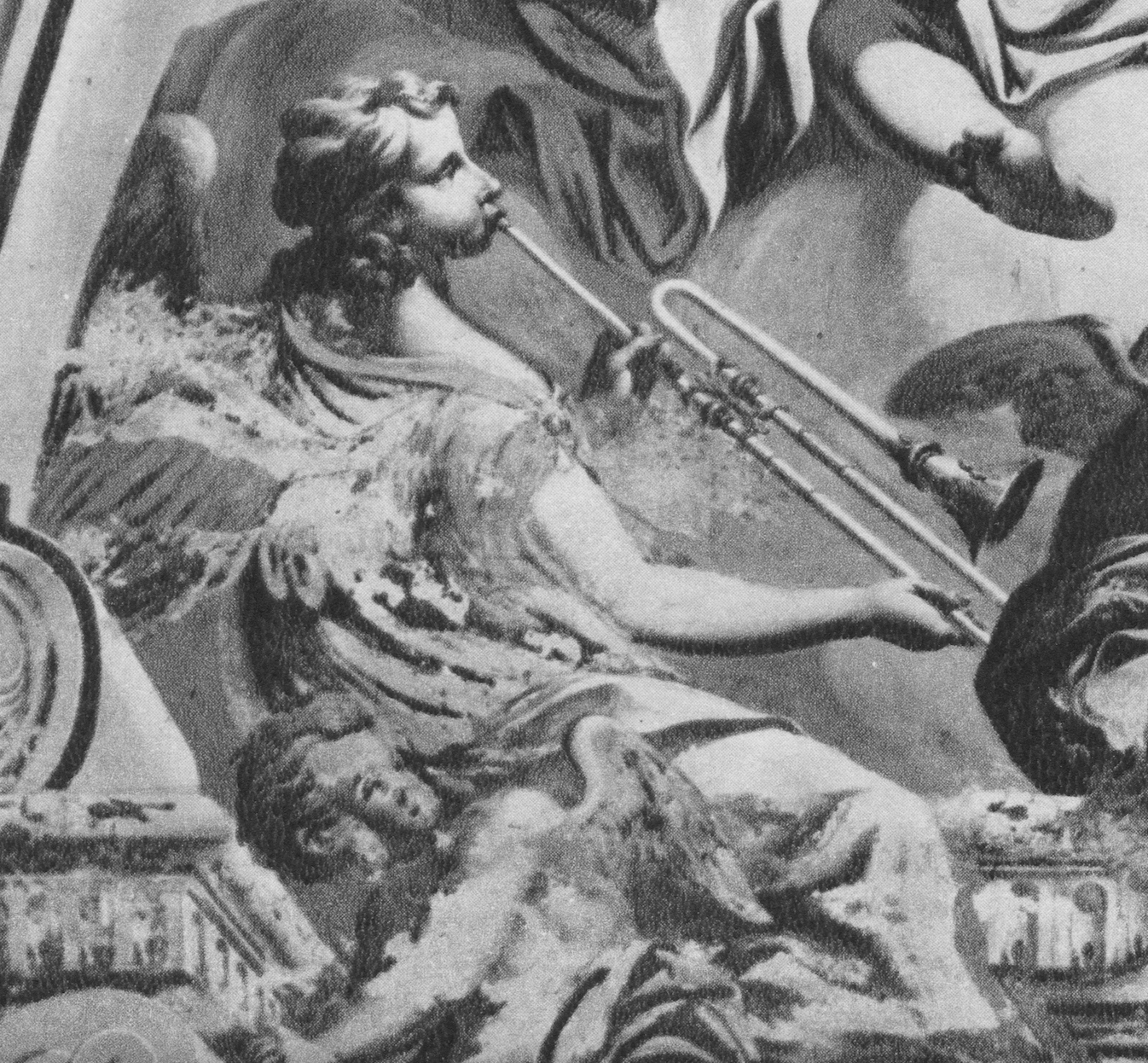

1679—Vienna, Austria: Matthias Joseph Hammer is appointed as a trombonist at the Imperial Court, a position he holds until 1711, when he is given a pension and released (Wigness 41; Selfridge-Field, Caldara 148).
1679—Vienna, Austria: Johann Heinrich Schmelzer (1623-1680) calls for 3 trombones in his Missa peregrina in honorem S. Rochi (Collver 165).
1679—Germany: Duties of the Baroque Stadtpfeifer, including trombones, are outlined in a poem by Jacob Lottich: “When Titan’s high course is about to bring midday, the clock strikes ten; Then the musicians meet with all their odds and ends, Form a group and let us have a tune for lunch on their trombones. The midday music can be heard from the town hall tower, Almost high up in the open air; it sounds for the honour of God and to inform the people, So that everyone knows each day at this time it is the tenth hour” (Whitwell, Baroque 154).
1679—Venice, Italy: The orchestra at St. Mark’s retains 3 trombonists on its payroll (Selfridge-Field, Caldara 119).
1679—Italy: S. Pasino scores for 2 trombones and 2 horns or 2 violins in his 4-part Sonata Duodecima detta la Savolda (Winkler 304).
c. 1680—England: A wash drawing attributed to Marcellus Laroon depicts a group of 17th century town waits—3 shawms and a trombone (see below image; public domain) (Herbert, Sackbut 77; Parrott, Grett and Solompne Singing).
1680s—Venice, Italy: 4 trombonists are employed on the regular payroll at St. Mark’s (Guion, Missing Link; Selfridge-Field, Caldara 119).
1680—Dresden, Germany: The Dresden court ensemble includes 3 players listed as trombonists/timpanists (Spagnoli 88).
1680—Vienna, Austria: Leopold Christian, Sr. is appointed as a trombonist at the Imperial Court, a position he holds until his death in 1730. He is the patriarch of a large family of trombonists at the court (Wigness 41; Selfridge-Field, Caldara 147). Composer Johann Joseph Fux, in a petition for Leopold’s salary raise, says the following about Christian’s abilities: “Leopold Christian, trombonist, who on his instrument has no equal, and he alone can meet the most difficult execution, I can advise nothing else than to award him 50 florins per month and an additional 10 florins per month for other duties” (Wigness 28).
1680-1685—Frauenberg bei Admont, Austria: Wallfahrtskirche (Pilgrimage Church) installs an organ. Decorating the organ case are several angels with musical instruments, including a trombone. In addition, along the front of the organ loft are several panels featuring paintings of music-making angels, including one angel playing trombone (see below image; public domain) (Forer, Orgeln in Österreich 224).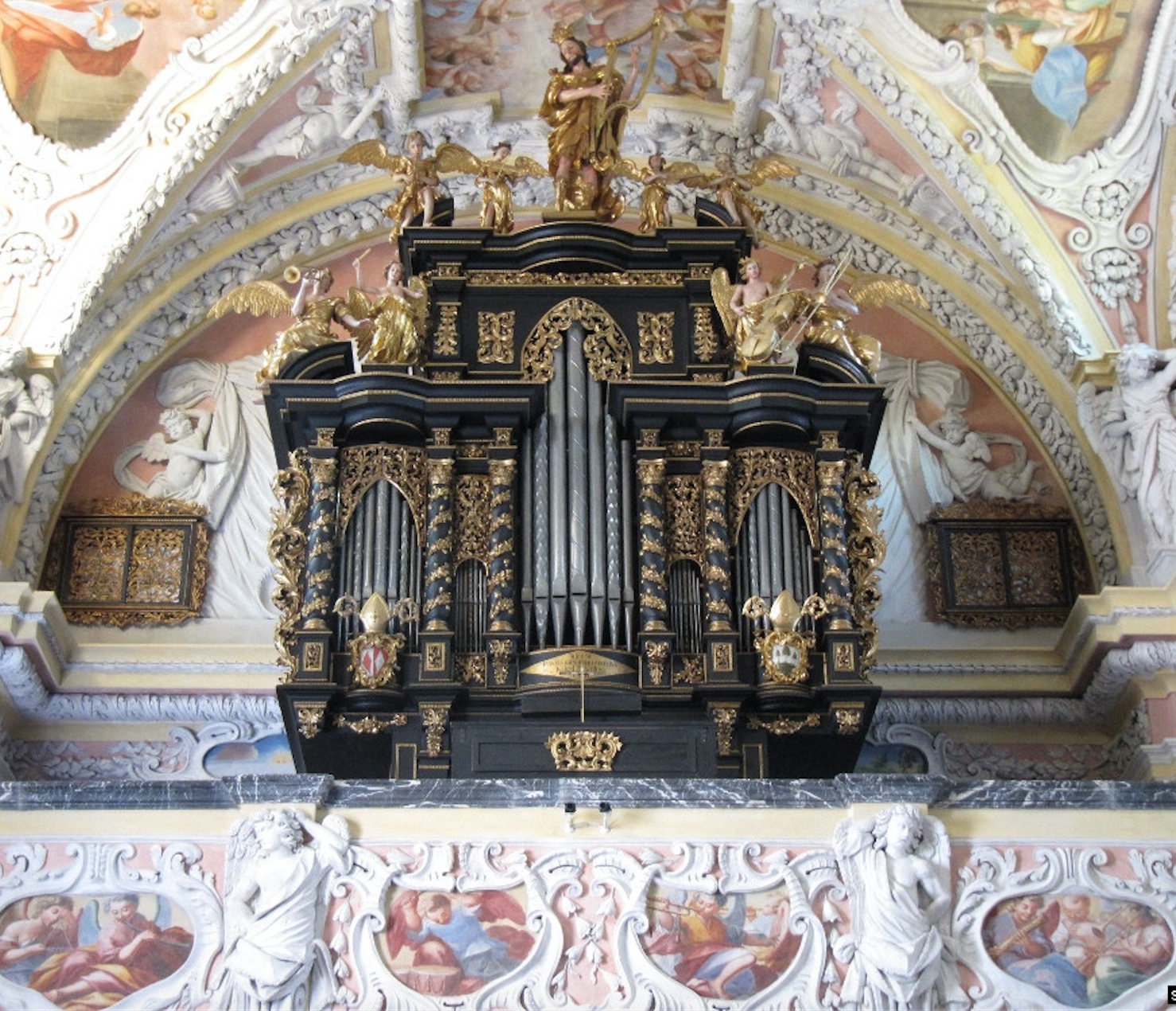
1680-1697—Vienna, Austria: The Hofkapelle orchestra retains 3 trombones on its regular payroll (Selfridge-Field, Caldara 124).
1680—Italy: Giovanni Freschi composes the opera Berenice, which calls for 6 trombones (Whitwell, Baroque 68).
1681—Rupert Ignaz Mayr writes “Beati Omnes” (from Sacri Concentus) for alto (or high tenor) voice, trombone (or viola), and continuo (Mayr).
1681—Genoa, Italy: Alessandro Stradella composes Inventione per un barcheggio for the wedding celebrations of Signori Carlo Spinola and Paula Brignole, members of two noble families. In the work, trombone is specified as part of the continuo. Precise instructions include the following: “All the basses with one trombone, but the trombone must play very staccato and with little breath.” The performance, as described by a chronicler of the time, takes place on the water: “Towards the evening on Thursday the ladies and gentlemen of this city had a sumptuous diversion on the bay, having been taken round the harbour by four galleys, besides a very great number of smaller boats, and then conducted aboard an apparatus [made] of barges, [which] formed a hall covered by light-weight silk and richly adorned. Here they were entertained with an interweaving of harmonious voices, poetry and instrumental music accompanied by the most exquisite food and refreshments of all sorts…” (Gianturco).
c. 1682—Mondsee, Austria: A panel painting in the Mondsee, Austria parish church depicts an angel playing trombone in the middle-bottom of the image (see below image; public domain) (Salmen, Bilder 57).
1682—Salzburg, Austria: Heinrich Biber (1644-1704) calls for 4 trombones in his Missa (“Salisburgenis”), including a “Crusifixus” scored for 4 bass voices and trombones (Collver 91; Chafe 50).
1682—Einsiedeln, Switzerland: In the ceiling of the Oratory of the Benedictine Monastery, Kloster Einsiedeln, a painting by Johannes Brandenberg (1661-1729) of Zug features a trombone with the Latin words Vox Verbi. The Oratory is the former Students’ Chapel and originally the sacristy of the Beichtkirche situated below (see detail and full image below; special thanks to David Yacus) (source: emblamata.ch).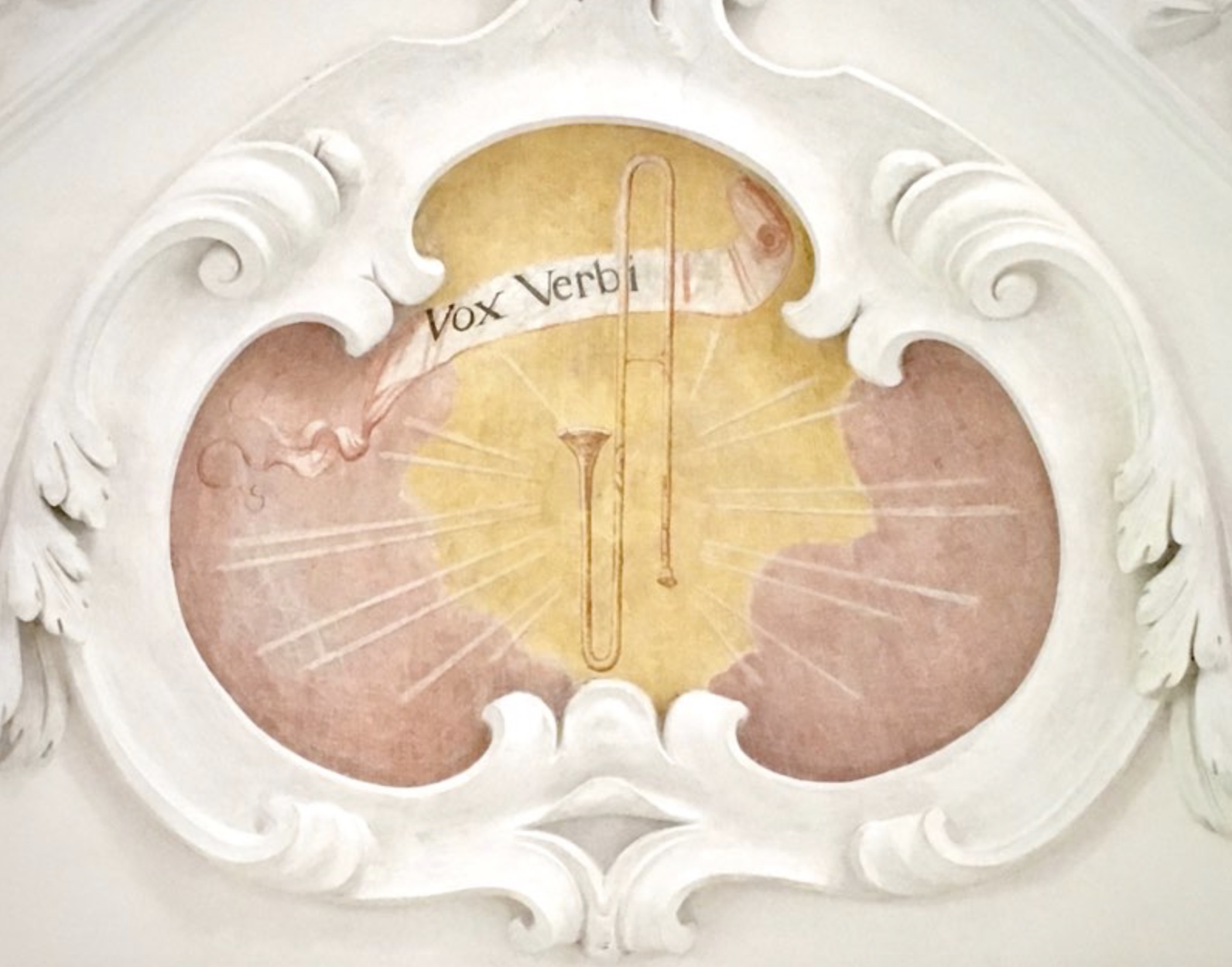
1682—The ship of Duke James of York (later King James II) is shipwrecked on the way to Scotland. At least 1 of the 6 royal musicians present on the journey is killed in the wreck: Thomas Greeting, a player of sackbut, violin, and flageolet (Love, The Wreck of the Gloucester).
1682—Salzburg, Austria: A copperplate engraving by Melchior Küsel, Musical Festival in the Salzburg Dome, 1682, depicts an antiphonal performance in the Salzburg Cathedral for one of the festivities of the Jubeljahr. Pictured in one of the choirs in one of the four balconies are what may be two trombones (see below image; public domain) (Salzburg, Museum Carolino Augusteum) (Chafe 44; Naylor 40).
1683-1732—Rome, Italy: Jean Charles Allet (c. 1668-1732), a French engraver who spends the bulk of his life in Rome, copies parts of Guido Reni’s fresco from San Gregorio Magno, Rome. Allet reproduces 6 of the 10 original angel musicians in his engraving, including the 2 trombonists (see below image; public domain) (British Museum).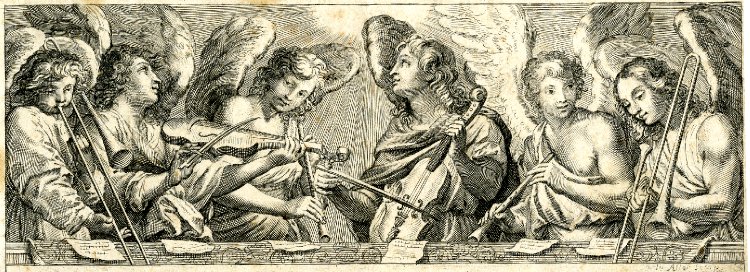
1683—Johann Rosenmüller writes Gloria in excelsis Deo, which calls for 4 trombones (Collver 157).
1684—Johann Krieger calls for 3 trombones in the “Zu ende des Kirchen-Jahrs” of his Newe Musikalische Ergetzligkeit (Collver 128).
1684—Germany: Daniel Speer, a former Stadtpfeifer, writes the autobiographical novel, Haspel-Hannß. In it, the character Bobbin Jack says, “When I had danced enough, I walked up near the musicians (which are called Spielleuthe) and listened to their playing and their silly jokes. Soon the master asked me if I desired to learn the lovely art. I answered, sighing, ‘Oh yes, Lord, if I could learn to play the heavenly bagpipes’ drone (meaning the trombone), then I would think myself as lucky as Paris.’ Then he said, ‘Come with the journeymen and carry home the violoncello, I will teach you as far as your skill and desire will carry you in four years.’” Later, during Bobbin Jack’s other travels, he auditions for Stadtpfeifer, playing trumpet, recorder, viol, trombone [Trombon], and other instruments (Howey, The Lives of Hoftrompeter and Stadtpfeiffer).
1684—Benedetto Sarti calls for 3 trombones in his Domine adjuvandum (Collver 162).
1684—England: John Bunyan mentions the sound of the sackbut in his famous allegory, Pilgrim’s Progress: “But what should be the reason that such a good man should be all his days so much in the dark?…He and his fellows sound the sackbut, whose notes are more doleful than notes of other music are: though indeed, some say, the bass is the ground of music” (Bunyan 361).
c. 1685—Vienna, Austria: It is probably in Salzburg circa 1685 that Georg Muffat composes his Missa in labore requies, which calls for two separate groups of 3 trombones. The mass is preceded by a sonata that calls for 3 trombones (Collver 141; Brewer, Instrumental Music 285).
1685—Germany: Daniel Speer, a former Stadtpfeifer, writes Recens fabricatus labor, oder neugebachene Taffel-Schnitz, which includes 7 sonatas for wind ensemble (including trombone). Among the collection is a sonata for 4 trombones and continuo. In addition, the following sonatas specify trombone: Aufzug a 6 (2 different works that call for 6 trumpets or cornetts, trombone), Sonata a 5 (2 different works that call for 2 cornetts, 3 trombones, continuo), Sonata a 4 (trumpet or cornett, 3 trombones, continuo), and Sonata a 4 (cornett, 3 trombones, continuo) (Collver 68; Whitwell, Baroque 160; Speer Sonata).
1685—Venice, Italy: San Marco has an orchestra of 34 players that includes 3 trombones (Selfridge-Field, Pallade 77).
1685—Johann Philipp Krieger calls for 3 trombones in the “Preise, Jerusalem” of his Cantate Domine (Collver 129).
1685—England: The choir of Westminster is followed in a procession by 3 of the King’s musicians, 2 sackbuts and a double courtal, all dressed in “scarlet mantles” (British Chronologist, 316; Langwill, Curtal).
1685—Krüger’s Psalmodia Sacra calls for trombone extensively (Galpin, The Sackbut).
1686-89—Rimov, Czech Republic: Outside the Loreto chapel of the Rimov pilgrimage complex, the open arcades with vaults are covered by frescoes. These frescoes include a painting of an angel playing trombone (see below image; public domain) (special thanks to Richard Seda).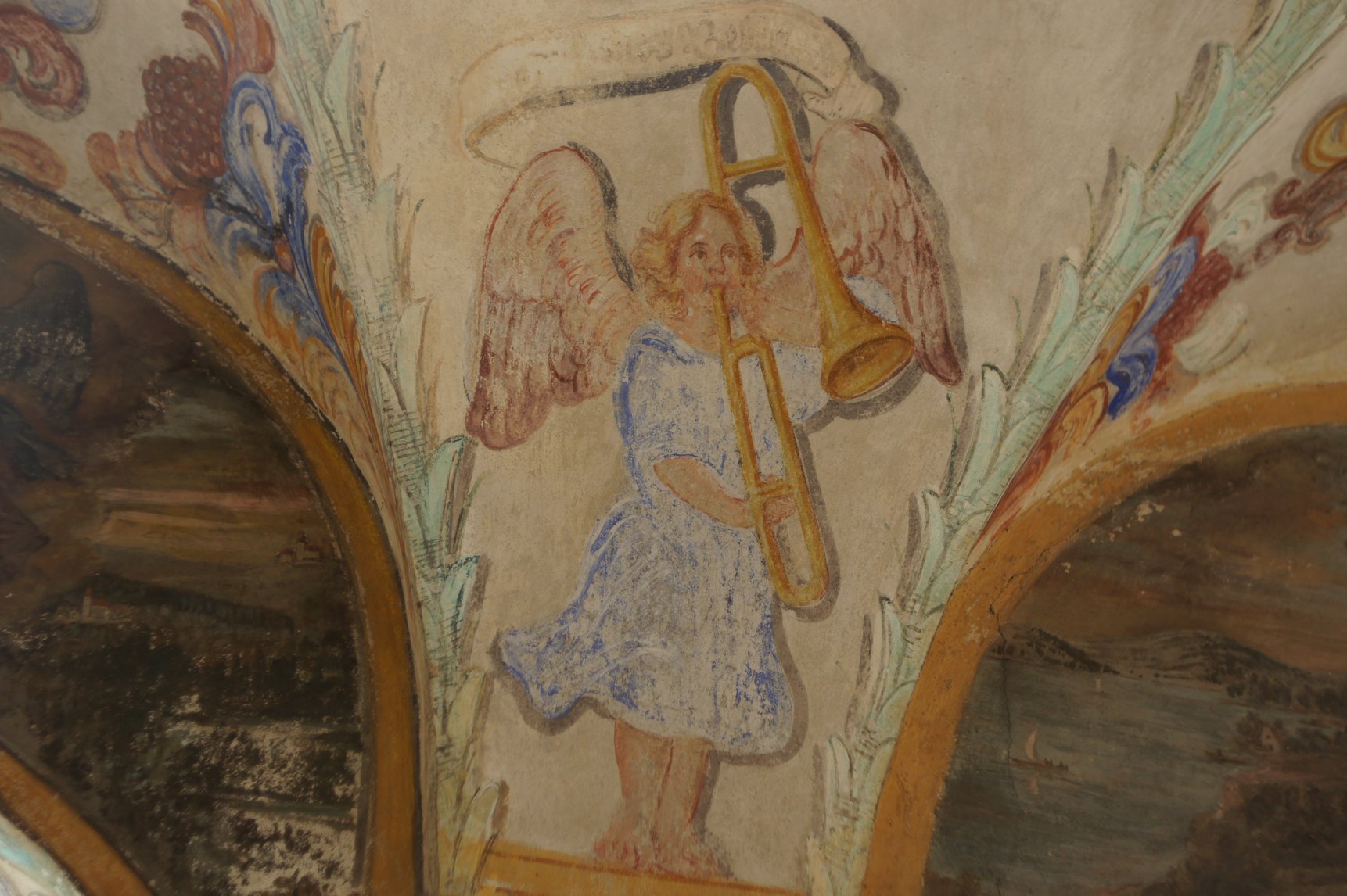
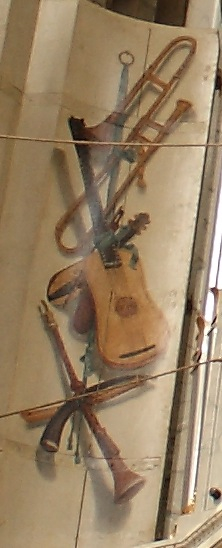 1686—Amsterdam, Netherlands: The organ for Amsterdam’s Westerkerk (west church) is built. Included on the organ shutters painted by Gerard de Lairesse (1641-1711) is a depiction of a trombone (see facing detail; public domain) (Die bemalten 606-07).
1686—Amsterdam, Netherlands: The organ for Amsterdam’s Westerkerk (west church) is built. Included on the organ shutters painted by Gerard de Lairesse (1641-1711) is a depiction of a trombone (see facing detail; public domain) (Die bemalten 606-07).
1686—J.P. Krieger scores for soprano voices, violin, and viola da gamba or trombone in Ich bin eine Blume zu Saron (Leonard, The Role of the Trombone…Mid- and Late Seventeenth Century).
1686-1709—Bologna, Italy: The orchestra at San Petronio employs 1-2 trombones (Enrico, The Orchestra 32).
1687—Cracow, Poland: An inventory of the musical instruments belonging to the Jesuit chapel lists 5 trombones, including one alto and one bass (Przybyszewska-Jarminska, Baroque part I, 156).
1687—Salzburg, Austria: Heinrich Biber writes Requiem a 15 in Concerto, probably for the funeral of Archbishop Maximillian von Khuenberg. The piece utilizes 3 trombones that double vocal parts (Chase 103).
1687—Bologna, Italy: estimates for the instruments used at the feast of San Petronio include 7 trombones: 1 “regular” and another 6 “extras” (Schnoebelen, Performance Practices at San Petronio, 43).
c. 1687—Wismar, Germany: The wooden ceiling of the Heiligen Geist Hospital is painted. Among the angel-musicians is an angel playing trombone (see below image; public domain). Special thanks to Maximilien Brisson.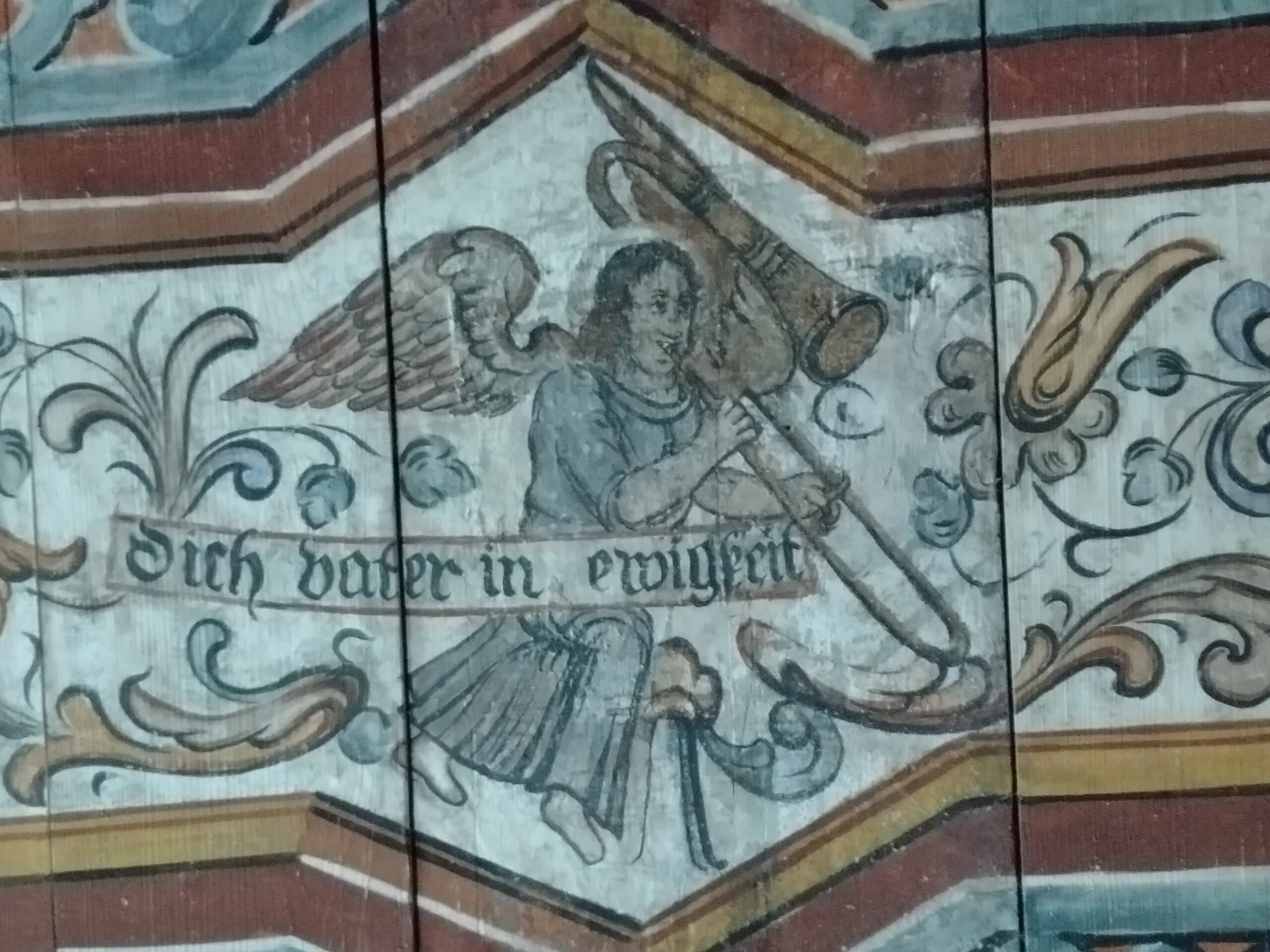
1687-1708—Arcangelo Corelli conducts at least five oratorios that add trombone to the orchestra (Guion, Short History).
1688—Johann Friedrich Fontana is appointed as a trombonist with the Viennese Imperial Court, a position he holds until his death in 1707 (Wigness 41). Selfridge-Field puts his hire date at 1670 (Selfridge-Field, Caldara 148).
1689—Seville, Spain: The church of the Hospital de los Venerables Sacerdotes, with walls and ceiling painted by Juan Valdés and his son Lucas Valdés, is completed. Among the numerous instrument-playing cherubs depicted on the ceiling is a cherub playing the trombone (see detail and full image below; public domain).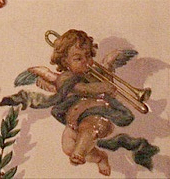
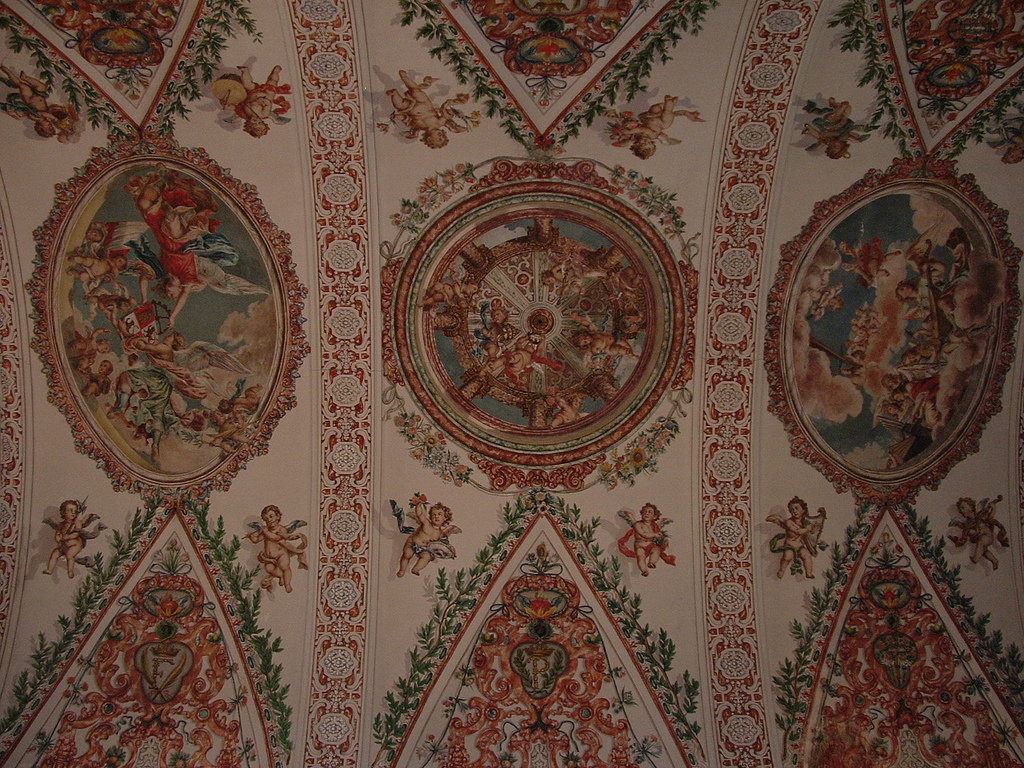
1689—An etching by Dutch engraver Romeyn de Hooghe titled L’Europe Allarmée pour le fils d’un Meunier includes what may be a rear-facing trombone (see upper-left of full image). The image is a satire against James II after he fled from England (see detail and full image below; public domain).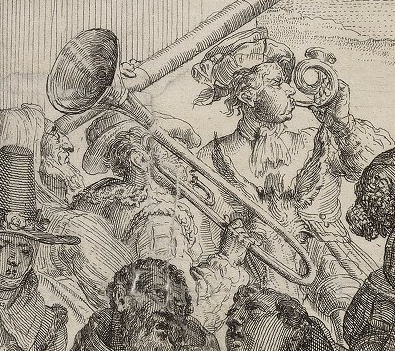
1689—Rome, Italy: Angelo Berardi writes, “The trombone is a type of trumpet that plays the bass in concertos and symphonies [and] makes a very good effect” (Guion, Missing Link).
1689-1700—Venice, Italy: 5 trombones are on regular payroll at St. Mark’s (Selfridge-Field, Caldara 119).
c. 1690—Cuzco, Peru: The Virgin of Montserrat, an anonymous painting from Iglesia de Santiago, includes a depiction of trombone. The trombonist in the painting is situated just to the right of the Virgin and is a very light, almost ghost-like depiction, the other musicians being even more difficult to distinguish (see below detail; public domain) (Nair, Localizing Sacredness). For a similar painting with the trombonist in much greater clarity, see 1693, below. For a version of the full painting and a brief discussion of 4 different Monterserrat paintings, all of which depict young trombonists, see here.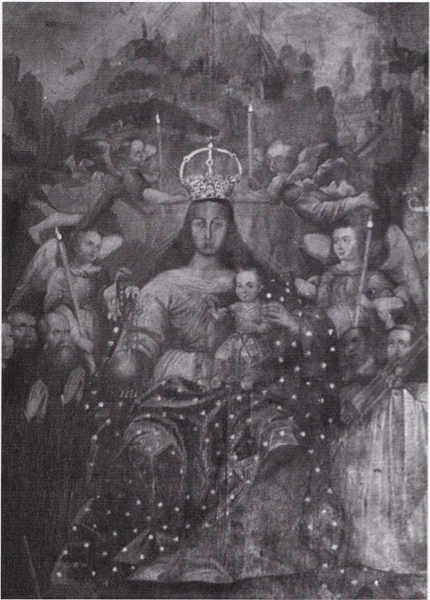
c. 1690—Schulze calls for trombone (or bassoon or violone) in his Historia Resurrectionis Domini nostri (Leonard, The Role of the Trombone…Mid- and Late Seventeenth Century).
c. 1690—Knüpfer calls for 4 trombones in Komm heilger Geist (Leonard, The Role of the Trombone…Mid- and Late Seventeenth Century).
c. 1690—Gdansk, Poland: At the church of St. John, chapel master Gottfriedt Nauwerck likely utilizes a sizeable instrumental ensemble, including at least 4 trombones, as indicated by works performed under his direction (Przybyszewska-Jarminska, The History of Music in Poland: The Baroque, Part 1, p. 115).
c. 1690—Puebla, Mexico: Composer Miguel Matheo de Dallo y Lana, chapelmaster of the Puebla Cathedral, composes Dixit Dominus in 4 choirs, including one of chirimías (shawms) and sacabuche (trombone) (Catalyne, Music of the Sixteenth to Eighteenth Centuries in the Cathedral of Puebla, Mexico).
1690—Johann Rosenmüller calls for 4 trombones in Siehe eine Jungfrau ist (Leonard, The Role of the Trombone…Mid- and Late Seventeenth Century).
1690—Salzburg, Austria: After this date, Heinrich Biber calls for 3 trombones in his Offertorium, Ne Cedite (Chafe 238).
1690—Salzburg, Austria: After this date, Heinrich Biber utilizes 3 trombones in an independent style (as opposed to colla parte) in his Requiem a 15 (Chafe 109).
1690—Lambach, Austria: A regal, originating circa 1580 from Lambach Abbey, includes a case dated 1690. The case features depictions of various figures, probably muses, playing musical instruments, including trombone (see detail and full image below; special thanks to Kellyn Haley) (Vienna, Kunsthistorisches Historical Musical Instruments Museum, SAM 636).
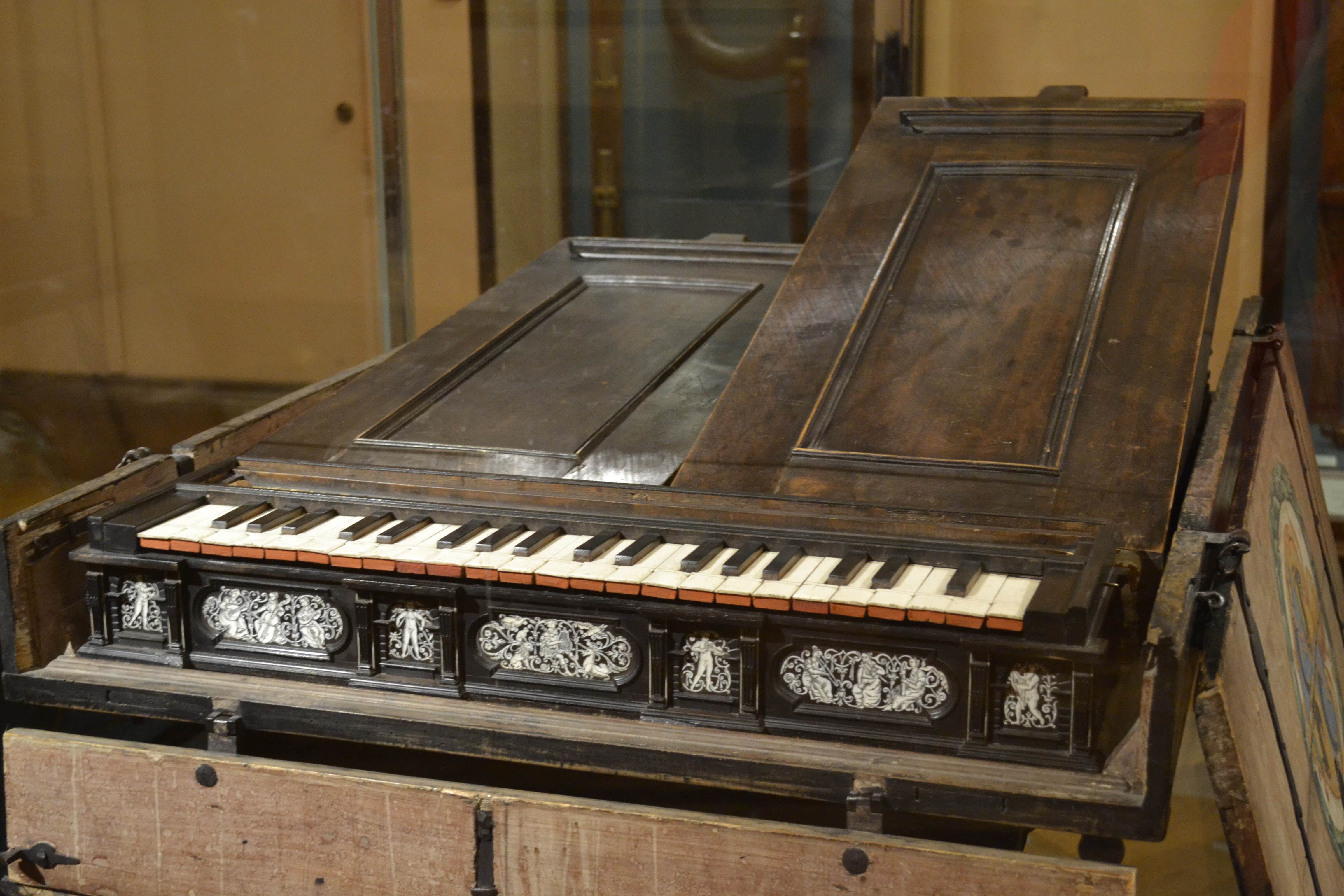
1690s—Poland: The well-known writer and poet Stanislaw Herakliusz Lubomirski (b. 1642) possesses a music ensemble consisting of trombonists, violinists, cornettists, curtalists, organists, and about 15 singers (Przybyszewska-Jarminska, The History of Music in Poland: The Baroque, Part 1, p. 91).
1690-1714—Venice, Italy: A hiring freeze at St. Mark’s puts an end to the hiring of new trombones at the cathedral. When the freeze is lifted, only string players are hired. The last trombonist dies in 1732 (Guion, Short History).
1690—Rome, Italy: At the court of Pietro Cardinal Ottoboni, a pastorale that is given utilizes a trombone in the sinfonia (Selfridge-Field, Caldara 121).
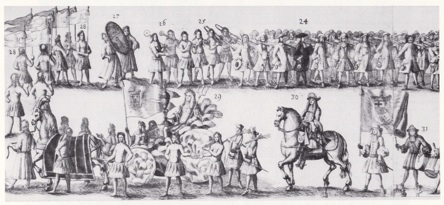 1690—Freising, Germany: Trombones are featured in a procession to a tournament celebrating the installation of Joseph Clemens, Archbishop of Cologne and Bishop of Regensburg, as Bishop of Freising. The trombones belong to a group representing Neptune and 4 tritons (2 cornetts and 2 trombones); see facing image; public domain (Bowles 383-86).
1690—Freising, Germany: Trombones are featured in a procession to a tournament celebrating the installation of Joseph Clemens, Archbishop of Cologne and Bishop of Regensburg, as Bishop of Freising. The trombones belong to a group representing Neptune and 4 tritons (2 cornetts and 2 trombones); see facing image; public domain (Bowles 383-86).
1691—Zolkiew, Poland (present-day Zovka, Ukraine): Jan III Sobieski, squire of Zolkiew, instructs that the parish school attached to the church be supplied with trombones, cornets, bowed string instruments, and monochords. More talented students are to be trained not only in chant, but in instrumental music (Przybyszewska-Jarminska, The History of Music in Poland: The Baroque, Part 1, p. 137).
1691—Bologna, Italy: A cupola painting in San Bartolomeo includes an angel playing trombone. It may have been painted by Giuseppe and Antonio Rolli in 1691. See below detail; public domain (special thanks to Bruce Dickey).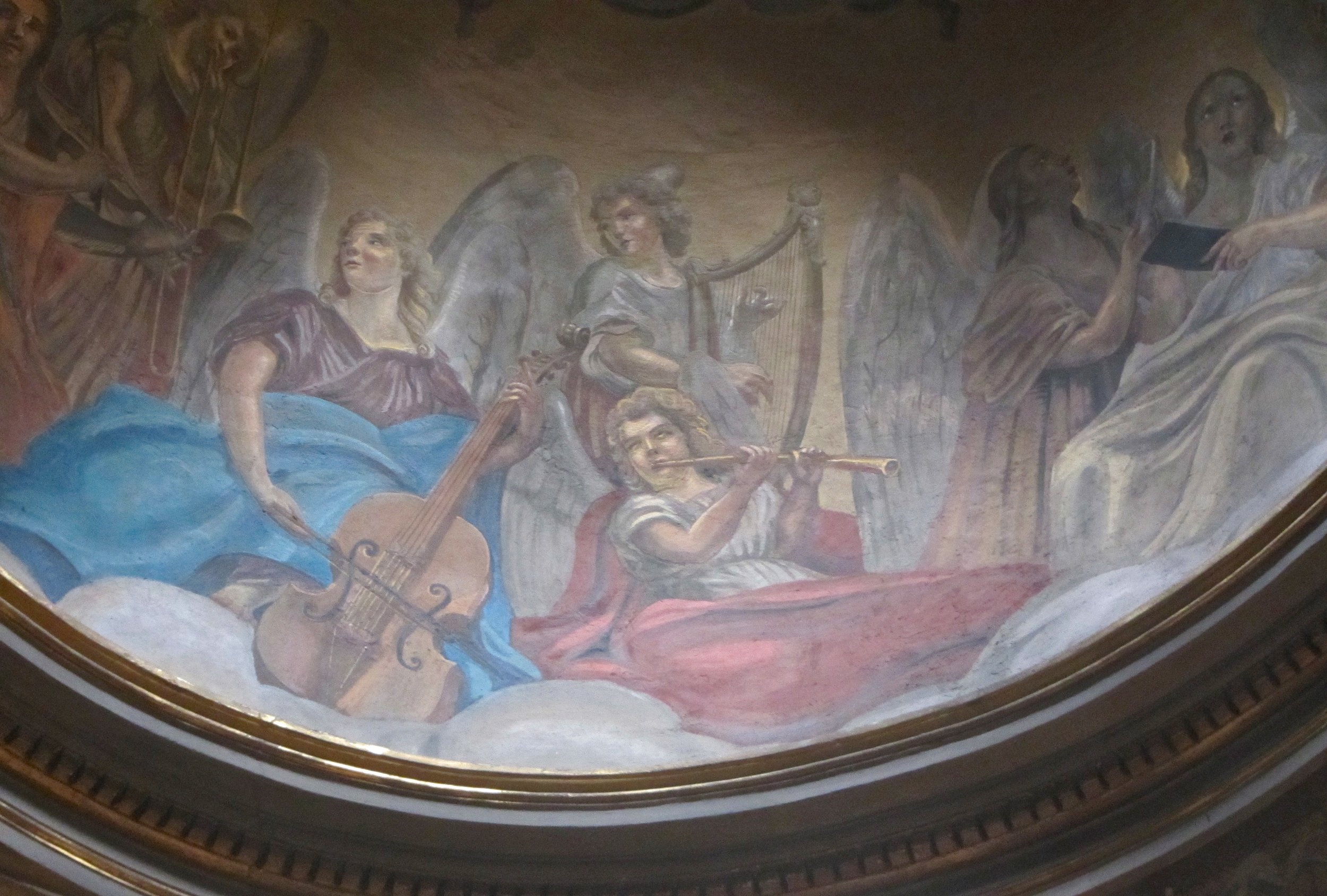
1691—Mexico City, Mexico: The Orchestra at Mexico City cathedral includes trombone (Stevenson Music in Mexico 148) and continues to use the instrument until at least 1760 (Mendoza de Arce 114).
1691—In Mexico City, Mexico: Trombone is one of several instruments called on to perform short solo passages in an intermezzo (Stevenson, Mexico City Cathedral Music).
1691—Mexico City, Mexico: Sor Juana Inés de la Cruz writes lyrics for a villancico to be performed in Mexico City Cathedral, including the following lines: “How well the cathedral honors her shepherd! Hear the peal of the bells, tan tan talan, tan tan! Listen to the clarion, tin tin tilin, tin tin! Better still, the sound of the trumpet, the sackbut [sacanbuche], the cornett, the organ, and the bassoon. Lord, what din they all make, so loud the violin can’t even tune!…To lend added sparkle to Peter’s sacred day, one instrument joins another in sweetest harmony: the shawm accompanying the violin. Tin tilin tin tin! Now the trumpet loudly blares, now the cornett trills, now the sackbut joins the fray of contending lines. Tan talan tan tan! (Stevenson, Sor Juana Inés). Instrumentation for the consort that accompanies the refrain and each stanza of the coplas is mentioned by Sor Juana in the following order: “clarín, trompeta, sacabuche, corneta, órgano, bajón, violín, chirimía, marina trompa, cítara, violón, vihuela, rabelillo, bandurría, arpa” (Stevenson, Sor Juana Inés; Stevenson, Christmas Music from Baroque Mexico 6).
1693—Cusco, Peru: Francisco Chihuantito’s painting, The Virgin of Monserrat, located in the parochial church of Chichero, Cusco, includes a depiction of a trombonist in a prominent position near the center of the painting. A cornetto player stands to the right of the trombonist, while two other similarly-dressed musicians, probably playing shawms, stand behind (see detail and full painting below; click on full image to expand; public domain image) (Velarde 82; Rosas 384; Pinilla 73).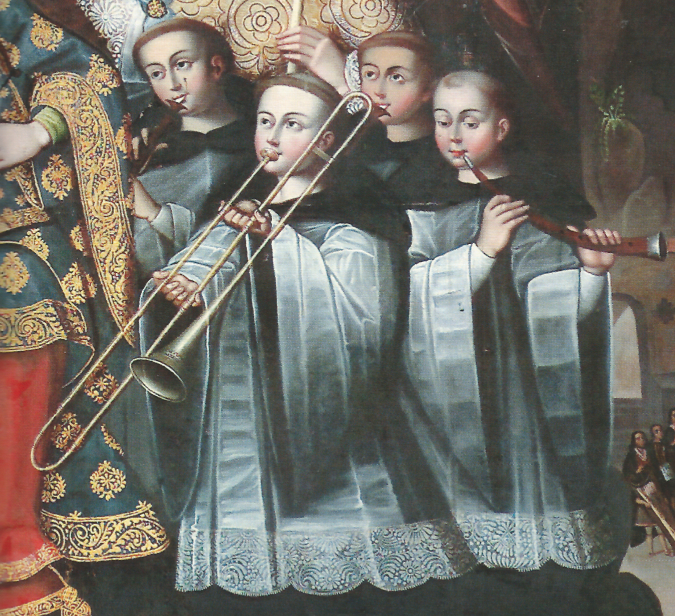
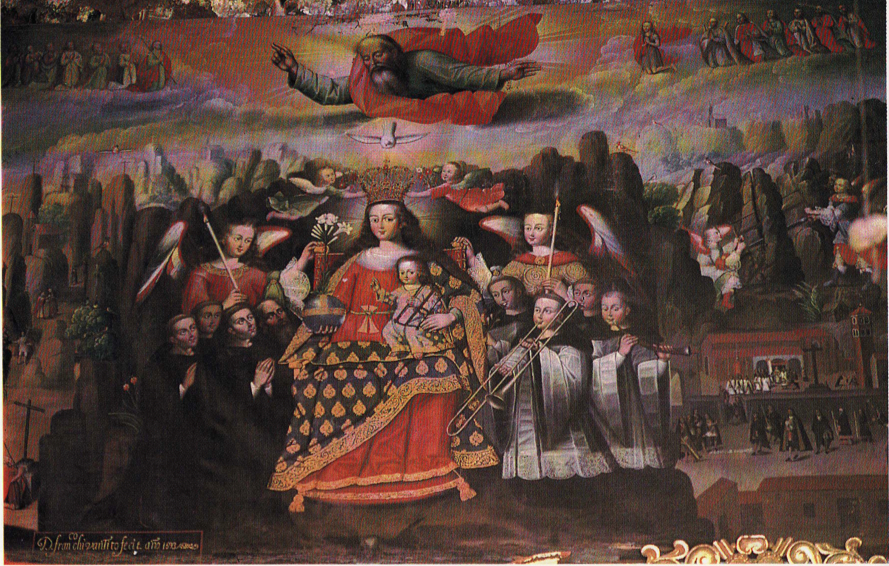
1693—Salzburg, Austria: Heinrich Biber’s Vesperae longiores ac beviores unacum litanies Lauretanis calls for 3 trombones and a cornett to double the 4-part chorus (Buelow, History 232).
1693-98—Gwardeiskoje, Russia (at that time Mühlhausen, Prussia): A painting by Gottfried Hintz (or Hinz) on the ceiling of the Kirche von Mühlhausen, an evangelical parish church, follows closely the top half of Pieter de Witte’s David Singing God’s Praise (c. 1590) (see below image; public domain). For more than a dozen other versions of this image, see here.
1694—Vienna, Austria: Antonio Draghi’s aria, “Si spezza il suolo” from Il libro con sette sigilli, features a trombone obbligato and is scored for bass voice, alto trombone, and bassoon (Carter, Trombone Obbligatos).
1694—Bologna, Italy: Estimates for the instrumentation of music at the feast of San Petronio include 10 trombones: 2 “regulars” and another 8 “extras” (Schnoebelen, Performance Practices at San Petronio, 43).
1694—Dresden, Germany: The Hofkapelle orchestra includes 3 trombones (Landmann).
c. 1695—Cambridge, England: Between 1685 and 1701, James Talbot of Trinity College lists details about several musical instruments, including 2 sackbuts, a tenor and a bass, providing specific measurements of both instruments. About the role of the sackbut, he says, “The chief use of Sackbutt here in England is in consort with our Waits or English Hautbois [shawms]. It was left off towards the latter end of King Charles II and gave place to the French Basson [bassoon]” (Baines, James Talbot’s Manuscript; Marcuse 811).
1696—Salzburg, Austria: Heinrich Biber utilizes 3 trombones, colla parte, in his Missa S. Henrici (Chafe 95, 234).
1696—England: Henry Purcell oversees dictionary definitions of musical terms for the 5th edition of Edwards Phillips’s dictionary, The New World of Words. His definition for “sackbut” shows the instrument is still considered a close relative to the trumpet: “Sackbut or Sagbut: (Spanish, Sacabuche) an Instrument of Wind Musick, somewhat like a Trumpet” (Tilmouth).
1696-97—Muri, Switzerland: Francesco Antonio Giorgioli decorates the church of Kloster Muri, a Benedictine monastery near Basel, Switzerland, with more than 200 frescoes, including an image of an angel-trombonist (see below image; public domain; special thanks to David Joseph Yacus).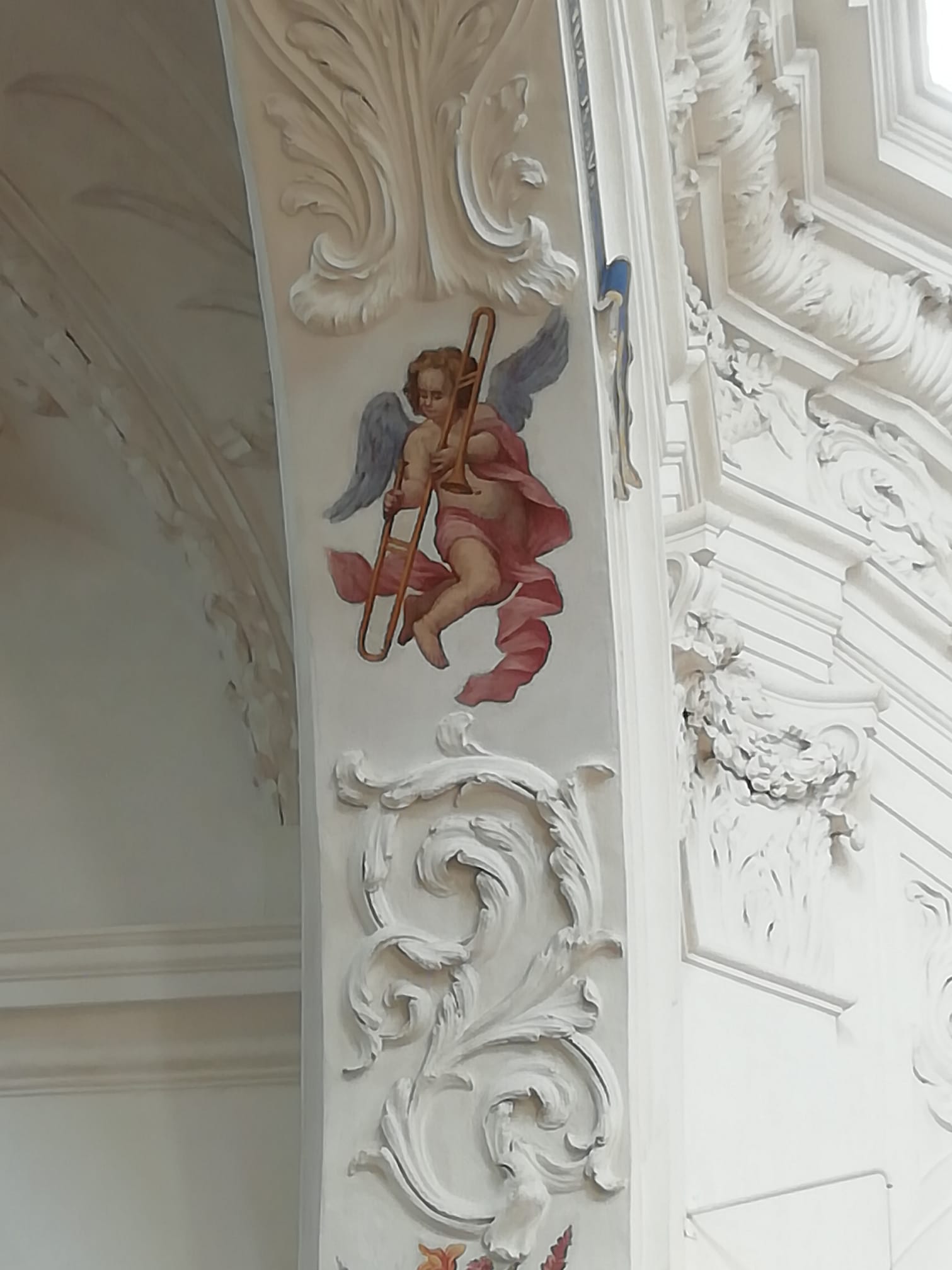
1696-1756—Bologna, Italy: The number of trombones used for the annual feast of San Petronio ranges from 2 to 6 players, considerably more than any other wind instruments (Schnoebelen, Performance Practices at San Petronio 44).
1697—Brno, Czech Republic: A 14-piece ensemble of all female performers at the Cistercian convent at the outskirts of Brno includes a female trombonist (Franziska Haldin), along with several trumpeters (Shifrin, Women’s Orchestra).
1697—Daniel Speer describes trombone technique in his treatise, Vierfaches Musikalisches Kleeblatt: “Because the alto, tenor, and bass parts can be played on the tenor trombone, it should be described first…As mentioned with the trumpets, trills are made with the chin. Some slur the trombone’s sound with the breath, but it comes out better and livelier when it is cleanly articulated with the tongue. Control in loud and soft [playing] is made with the breath, as in all wind instruments. This instrument requires no special physical vigor. It can be learned quite soundly by a boy eight, nine, or ten years old, because he has enough physical strength to play a tenor trombone—especially on a bass part, as this requires only a normal amount of air” (Speer Vierfaches 174-7). His description and position charts show four diatonically-numbered positions and indicate that, at this time, tenor trombone is probably pitched in A, alto in D, and bass in D. Also of interest is that, although trombone pedal notes do not appear in written music until many years later (1831), pedal A is notated in Speer’s slide position chart (Speer Vierfaches 175-8). The author provides, along with his trombone description, two 3-part sonatas for trombones (see below image for first page of first sonata; public domain) (Speer Vierfaches179-83). (Speer Vierfaches 179-83). In a separate section of the treatise, Speer discusses how to organize music performances in a small town, saying, “Since the middle voices (alto, tenor, and bass) are most commonly played on viols or trombones in the churches, the guild musicians suffer only the slightest disadvantage in their accustomed wages by the students playing these parts, though the guild musicians make many idle complaints” (Speer Vierfaches 204).
1697—Germany: Composer Gottfried Reiche writes 24 neue Quatricinia for cornett and 3 trombones for the Stadtpfeifer (Guion, Trombone 156).
1697-1703—Görlitz, Germany: Eugenio Casparini’s famous organ in the church of St. Peter und Paul features decorative sculpures of angels sitting atop the pipe structure. Each angel holds 2 instruments; 2 of the angels, sitting on opposite outside edges of the structure, hold trombones while playing trumpets (see below detail; public domain) (Sonnaillon 92).
1698-1701—Vienna, Austria: The Hofkapelle orchestra retains 4 trombones on its regular payroll (Selfridge-Field, Caldara 124).
1698—Salzburg, Austria: Heinrich Biber calls for 3 trombones in his Missa Alleluia (Collver 91; Chafe 233).
1698—Vienna, Austria: A trombonist by the name of Christian Christian [sic] is hired as trombonist at the Hofkapelle, where he retains his post until 1712. He is one of a large family of trombonists employed at the Imperial Court (Selfridge-Field, Caldara 147).
1699—Württemberg, Germany: A musician by the name of Georg Michael Schwartzkopff is paid by the court for teaching 2 apprentices a variety of wind instruments, including trombone (Owens 234).
1699—Quito, Ecuador: Gabriel Guacarache, a native Ecuadoran, is hired as cathedral trombonist (Stevenson, Music in Quito).
1699—Andreas Hofer (1629-1684) calls for 3 trombones in his Missa Archiepiscopalis (Collver 123).
c. 1700—Salamanca, Spain: A wall painting located at Oficio de San Nicolas in the Convento de San Esteban, possibly by Antonio Palomino, includes a barely-visible angel playing trombone (see lower-middle of below image; public domain; photo from this page on dulcian iconography).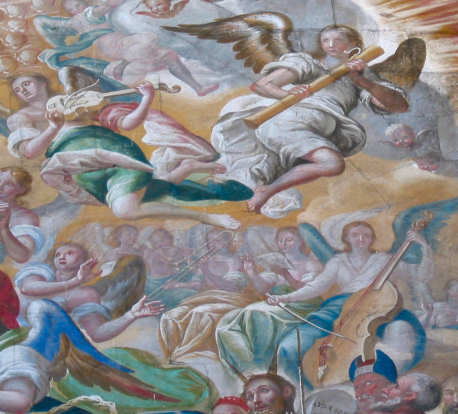
c. 1700—Nuremberg, Germany: A movement of Johann Pachelbel’s cantata Lobet den Herrn in seinem Heiligtum calls for solo alto voice with solo trombone (Samuel 88).
c. 1700—Italy: An inventory of musical instruments owned by the Pieta lists one trombone (Baldauf-Berdes 171).
c. 1700—Salzburg, Austria: Heinrich Biber’s Litania de S. Josepho a 20 calls for 3 trombones (Chafe 179).
c. 1700—Passau, Germany: A putto decorating the interior of St. Michael’s church holds the trombone in an improbably way, necessitating an unusual extra bend of tubing at the leadpipe (see below image; public domain).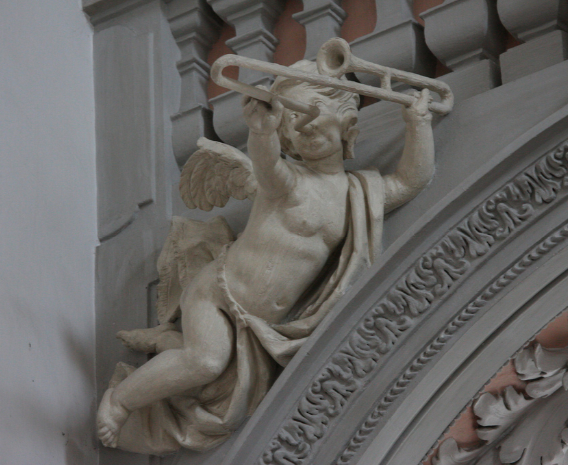
c. 1700—Hof, Germany: An organ loft panel in Hospitalkirche, painted by Heinrich Andreas Lohe, features an angel-trombonist (see below image; public domain) (special thanks to Audrey Christensen Manganaro).
1700—Vienna, Austria: Emperor Joseph I maintains a wind band of 6 trombones, 2 cornetts, 4 bassoons, and 5 oboes (Whitwell, Baroque 52).
1700—Bologna, Italy: A document that appears to be a seating chart for the musicians at San Petronio indicates 3 trombones (Schnoebelen Performance Practices at San Petronio, 40).
1700—Knüpfer scores for voices, 2 violins or cornettini, viola da gamba or bambardo or trombone, and organ in O benignissime Jesu (Leonard, The Role of the Trombone…Mid- and Late Seventeenth Century).
1700—Leipzig, Germany: Bach’s predecessor, Johann Kuhnau, writes a novel (Der musikalische Quacksalber) in which he includes several passages about trombone. In the first, a character states, “I played the trombone. Most recently in a town I did the city pipers the honor of composing for them for the second Sunday of Advent a spiritual song using nothing but trombones and helped them perform it from the tower. For this I used the discant trombone and the people were so delighted by my playing some even thought Judgment Day had arrived and the Angel was sounding the trumpet” (Kuhnau 26-27). Later, a different character says, “Rather, I only want to talk about those instruments that must be blown by the mouth. What do the angels, those heavenly and most perfect musicanti play other than these? For if we encounter something about music in the Scriptures, we hear either of a trumpet or a trombone” (Kuhnau 28). Finally, a third character, arguing before Apollo and the muses that wind instruments are superior to string instruments, explains, “Nothing comes so close to the human voice as do the wind instruments. Just listen to a well-played trombone, cornet, or oboe; if words were spoken to it, one might well swear that he was hearing the most beautiful castrato or other vocalist. On the other hand, with zithers, violins, lutes, and the like and with even ten voices joining in, no one would ever think of a vocalist, much less of an equivalent to the human voice. One notes this all the more if one hears a choir of wind instruments from afar. Experience shows that when, say, our municipal pipers play a church song on trombones only from the tower, we are moved beyond all measure and imagine we are hearing the angels sing” (Kuhnau 133-134).
Late 17th Century—Bologna, Italy: An angel holding what is possibly a rear-facing trombone sits atop the organ case/backdrop of the older of two organs in San Petronio (see below image; special thanks to Adrian King, photographer).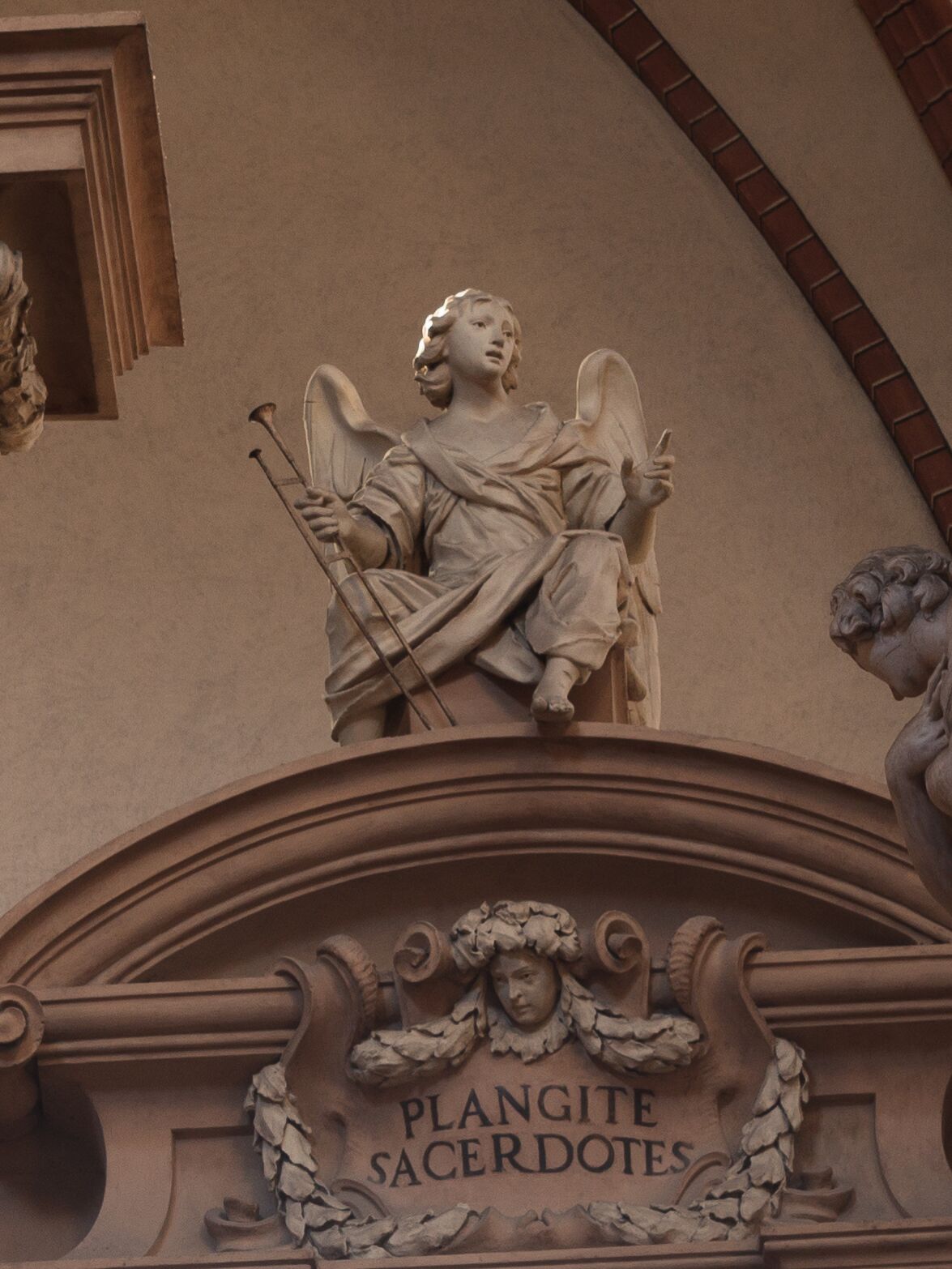
Late 17th century-18th century—Au am Inn, Germany: A painting at the Klosterkirche Maria Himmelfahrt includes a depiction of an angel playing trombone among a cluster and angel musicians (see detail and full image below; public domain).

